
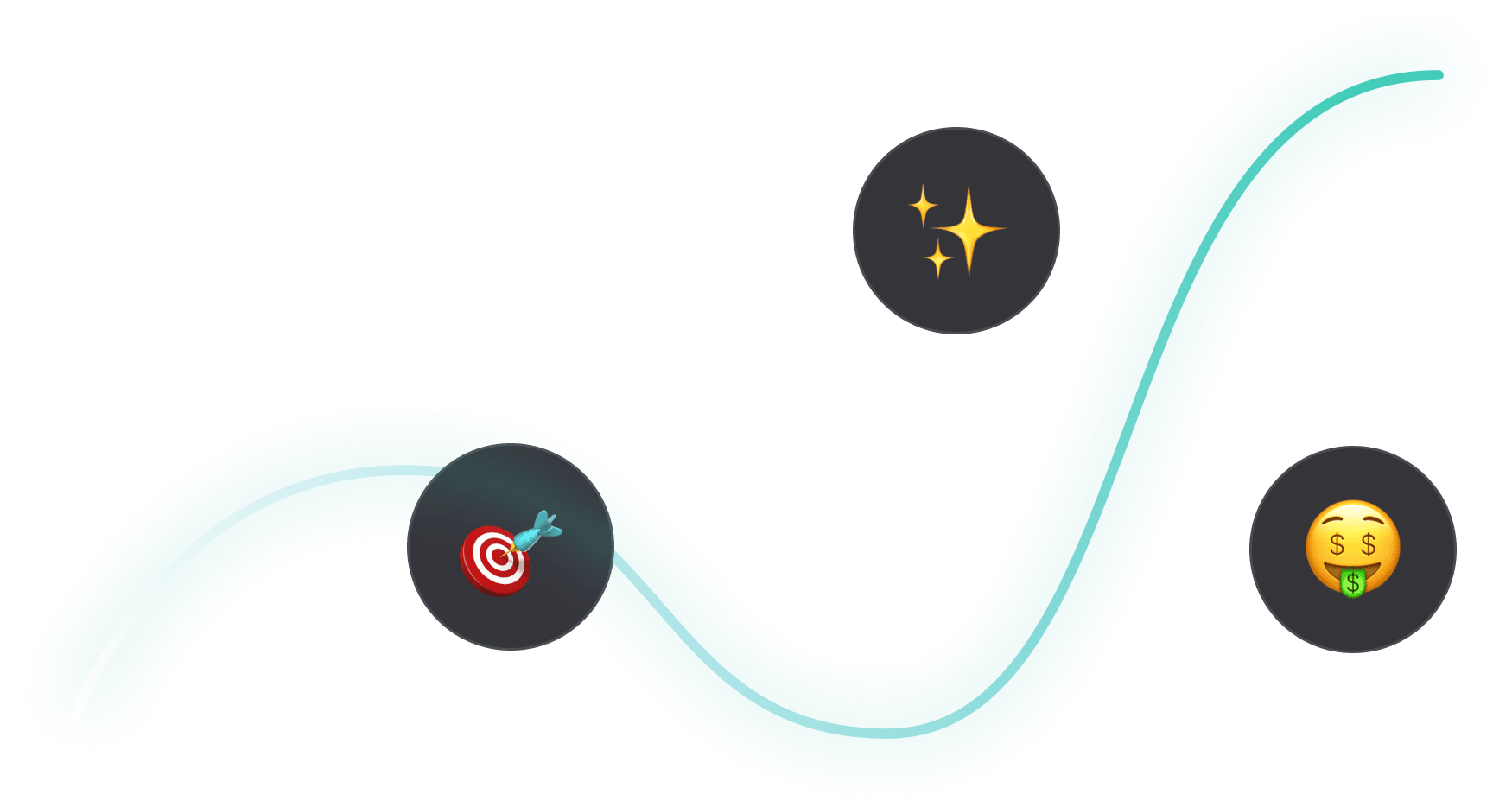
Become a B2B SaaS Ads Expert

10 Expert Tips For Scaling Google Ads Demand Capture
Do you need to scale your paid search campaigns and find new ways to increase demand capture?
As the head of Marketing at Catalyst, I build and mentor teams to maximize ROI in paid ad channels including Google.
Here’s my top 10 tips & tactics to scale your Google ads efforts.
(In no particular order, they all matter)
TABLE OF CONTENTS:
- Tip #1 - Leverage Dynamic Keyword Insertion (DKI)
- Tip #2 - Tap into Device & Location Bid Modifiers
- Tip #3 - Shift Towards Smart Bidding ASAP
- Tip #4 - Sync Your CRM with Google Ads
- Tip #5 - Steer Away From Broad Match As Much As Possible
- Tip #6 - Take Advantage of the Google Ads Editor
- Tip #7 - Lean on Google Ads Script & Rules
- Tip #8 - Exclude Search Partners & Display Network
- Tip #9 - Install Behavioral Analytics Tools for Landing Page Optimizations
- Tip #10 - Consider Bing as a Second Demand Capture Channel
Tip #1 - Leverage Dynamic Keyword Insertion (DKI)
DKI is a powerful method to improve the relevancy of your ads based on user search terms.
When managing ad groups with multiple keywords on a similar theme, this technique ensures that you are displaying ads that closely align with users' query terms.

How Dynamic Keyword Insertion Works:
DKI automatically updates the ad’s headline to include the exact keywords that triggered the ad.
This way, the ad's first impression is highly relevant to the user's search, which improves overall engagement.
Even a slight increase in click through rate (CTR) can impact the performance of a campaign by driving more traffic to the landing page.
Best Practices for Using Dynamic Keyword Insertion:
Prioritize the First Headline: Always aim to have the first headline of your ad matches as closely as possible to the user’s search query.
Group Keywords by Theme: Make DKI more effective by grouping your keywords by themes.
There are generally 6 buckets of themes for search ads:
- Brand
- Non-brand
- Competitive
- RLSA (Search Remarketing)
- Content
- Dynamic Search Ads
With this organization, DKI can create more coherent ads that display the most relevant headline for each bucket.
Tip #2 - Tap into Device & Location Bid Modifiers
A critical aspect often overlooked in Google ads is the optimization of device and location modifiers.
For most B2B SaaS campaigns, the quality of traffic can vary significantly across different devices.
Desktop vs. Mobile vs. Tablet:
Typically, desktop traffic yields the highest quality in terms of conversion rates and user intent.
Users on desktops are generally more engaged and possibly in a professional setting, compared to mobile users who might be multitasking or browsing casually.
Tablets often perform the worst in terms of conversion rates and traffic quality, which is why many advertisers choose to exclude them entirely from campaigns.
Strategic Use of Location Modifiers:
If you target several states or countries, you should modify your bids based on the areas that perform best.
This could mean adjusting bids upward in high-performing regions to capture more traffic or decreasing bids in lower-performing areas to conserve budget.
In extreme cases, you can exclude low-performing regions altogether.

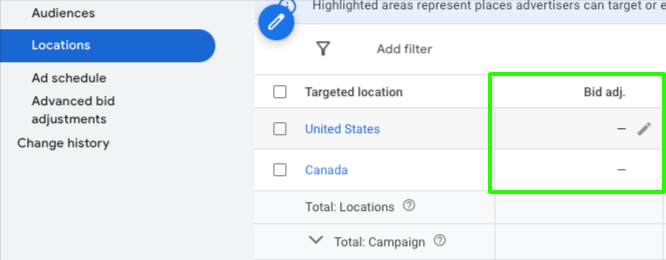
Pro Tip:
Start with a conservative approach focused on proven strategies. As results come in and budget allows, gradually introduce new variables and expand your focus to optimize the overall campaign performance. Maintain detailed records of campaign performance across different devices and platforms. This data will be invaluable for making informed decisions about where to allocate resources most effectively.
Tip #3 - Shift Towards Smart Bidding ASAP
Smart bidding strategies can help improve campaigns’ performance by focusing on conversions rather than clicks.
The Maximum Conversion strategy is particularly effective, as it lets Google optimize your bids to meet a specific CPA target, ideal for campaigns with regular conversions.

Key Considerations for Smart Bidding:
Google recommends having at least 30 conversions per month to effectively utilize Target CPA.
However, for campaigns with lower conversion rates, setting a minimum threshold of 10-15 conversions can still be sufficient.
Ensure that your conversions are properly set up and that Google receives clear signals about which conversions to prioritize by setting specific values for each conversion action.
This is crucial for smart bidding algorithms to function properly, as mixed signals can dilute the focus of your campaign optimization.
Pro Tip:
For businesses, especially in B2B sectors where conversion volumes are low, it's important to track higher funnel events. These can include engaged visits, interaction with forms, and even form abandonment. Each of these steps can be set through Google Tag Manager (GTM), providing richer data for optimization. Apply a structured conversion funnel that captures various stages of user engagement. From initial website interaction to form submissions or CRM entries, each stage should be defined and tracked as separate conversion events. You can then design custom goals and bundle your conversion actions together to add them to your campaigns.
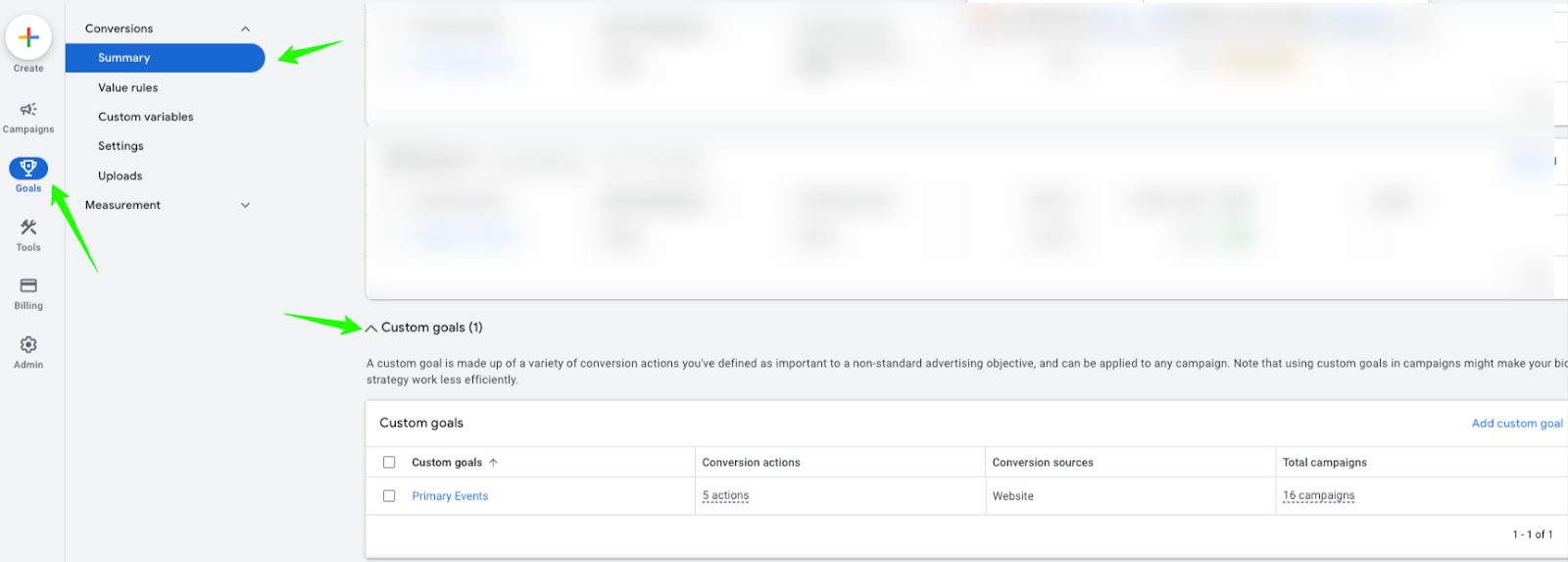
Tip #4 - Sync Your CRM with Google Ads
Performance marketers thrive on optimizing for meaningful conversions. It will take emotions out of the decision-making process.
Integrating CRM lifecycle stages into Google Ads can profoundly impact your ad optimization and overall marketing strategy.
By linking stages such as MQL (Marketing Qualified Lead), SQL (Sales Qualified Lead), opportunities, and customer status directly from a CRM platform like HubSpot, you enable a more nuanced and powerful approach to ad targeting and bid adjustments.
How to Implement Your CRM Sync:
Depending on your CRM system, various tools and plugins can facilitate this integration. Ensure that the tool you choose can sync data reliably and in real-time to maintain accuracy in your campaigns.
Define which CRM milestones are important for your campaigns and set Google Ads to track these as conversions
Use the data from your CRM to set up automation rules in Google Ads. For example, you could decrease bids or pause campaigns if the cost per SQL exceeds a certain threshold, ensuring you maintain profitability.
Regularly review the data flow and synchronization between Google Ads and your CRM to ensure accuracy. Adjust your strategies based on new insights and continually refine your approach to improve outcomes.
Tip #5 - Steer Away From Broad Match As Much As Possible
Broad match can drive a high volume of traffic due to its extensive reach. This can result in a large number of conversions, which initially might seem cost-effective.
However, the quality of these conversions often needs to be revised when scrutinized more deeply in the sales funnel.
Despite lower upfront costs, the conversions from broad match often fail to convert into valuable leads or sales.
They may also attract clicks from irrelevant queries, leading to wasted ad spend and diluted performance metrics.
Best Practices for Keyword Match Types:
Phrase match offers a balance by allowing your ad to show only when a searcher's query includes the exact phrase or close variations of the phrase, in the same order. This strikes a better balance between reach and relevance, providing more control than Broad match type.
Exact match targets queries that are much closer to the keywords.
While this reduces reach, it increases the relevance and quality of traffic, making it ideal for targeting high-intent users and optimizing conversion rates.
Regardless of the match type used, a comprehensive negative keyword list is crucial.
Finally, test different match types to see what works best for your specific campaigns. This could mean comparing the performance of Phrase match versus Exact match or testing different variations of your keywords.
Tip #6 - Take Advantage of the Google Ads Editor
Google Ads Editor is an indispensable tool for marketers aiming to streamline their campaign management processes.
This desktop application allows users to manage their Google Ads campaigns offline, offering robust functionalities for bulk editing and optimization.
Google Ads Editor is particularly advantageous for managing large accounts with numerous campaigns and extensive lists of keywords.
Best Practices for Using Google Ads Editor:
Develop a standardized template with predefined columns and settings that align with your campaign's requirements.
This setup ensures that you can quickly import data from spreadsheets directly into Google Ads Editor without compatibility issues.
Always synchronize Google Ads Editor with your online account to ensure all changes are up-to-date and to avoid discrepancies between offline edits and online status.
Before uploading changes to the live environment, use the review function to ensure accuracy and prevent potential errors from impacting your campaigns.
While Google Ads Editor is incredibly powerful, it does have a learning curve.
Invest time in learning its features and shortcuts.
Tip #7 - Lean on Google Ads Script & Rules
Automation is a key component in optimizing campaigns. Google Ads scripts and rules offer powerful tools to automate routine tasks and strategic operations.
Scripts allow for advanced, customized automation that can modify bids, pause ads, or adjust budgets based on specific conditions.
Rules can be set to trigger based on performance metrics such as CTR, conversion rates, or cost per acquisition.
For example, automatically increasing the budget for high-performing campaigns or reducing bids for underperforming keywords helps maintain efficient spending.
Utilize scripts to automatically apply a tracking template across all campaigns, incorporating dynamic elements like campaign and ad group names.
This will detach personal bias from campaign management. Scripts and rules operate based on data, not preference, enabling objective decisions that focus solely on performance metrics.
You must regularly review the outcomes of automated actions. Automation is powerful, but it requires oversight to ensure it aligns with changing campaign goals and market conditions.
Tip #8 - Exclude Search Partners & Display Network
When managing Google Ads, especially for substantial budgets, it's crucial to ensure that every dollar spent is driving quality traffic and conversions.
A common oversight is not excluding search partners and the display network from search campaigns.
While these features can increase visibility, they often compromise the quality of traffic and the overall effectiveness of your campaigns.
Understanding the Impact by Network:
Including Search Partners and Display Networks can inflate your impressions without a corresponding increase in clicks.
This dilution of CTR can harm your campaign's overall performance metrics, misleading you about its effectiveness.
Google's quality score is a critical metric in determining your ad rank and the cost per click (CPC) you pay.
A lower CTR resulting from irrelevant impressions on search partners and display networks can decrease your quality score, leading to higher costs and reduced ad placement.
Pro Tip:
Conduct regular audits of your Google Ads accounts to identify any inefficiencies or overlooked settings that could be draining your budget or diminishing your campaign’s effectiveness. While Google may provide recommendations, always assess them critically in the context of your specific campaign goals and historical data. Consider experimenting with settings on a smaller scale before applying them broadly, especially when dealing with large budgets. This cautious approach allows you to gather data and make informed decisions based on actual performance metrics.
Tip #9 - Install Behavioral Analytics Tools for Landing Page Optimizations
One of the most effective strategies for enhancing landing page effectiveness is to implement behavioral analytics tools, such as Hotjar or Microsoft Clarity.
These tools provide deep insights into how users interact with your page, allowing for data-driven improvements.
The Importance of Behavioral Analytics:
Most of these tools offer features like heatmaps, scroll tracking, and session recordings that reveal how users interact with your landing page.
You can identify which parts of the page attract the most attention and where users lose interest.
You can make informed decisions about layout adjustments, content placement, and calls to action.
For instance, if users frequently abandon a form, you might simplify it or adjust its placement on the page to increase completion rates.
Use the insights gathered to A/B test different versions of your landing page.
Pro Tip:
Before implementing any changes based on behavioral data, be clear about what you’re trying to improve. Having specific goals will guide your optimization efforts, whether it's increasing time spent on the page, reducing bounce rate, or boosting form submissions. Combine quantitative data from analytics tools with qualitative feedback from user surveys or feedback forms. Keep a detailed record of all changes made and the results they yield. This documentation will help you understand what works, what doesn’t, and how future landing pages can be designed for maximum impact.
Tip #10 - Consider Bing as a Second Demand Capture Channel
To extend the reach of your successful Google Ads campaigns without significantly increasing your budget, consider importing your best campaigns into Bing Ads.
Bing, while smaller than Google, still captures a unique audience segment that may not overlap completely with Google users. This can increase your campaign's overall reach and exposure.
Generally, competition on Bing is lower than Google Ads, leading to lower cost-per-click (CPC) rates.
Hope you found these 10 tips helpful!
For more tips or to connect, please reach out via LinkedIn.
From Clicks to Conversions: Master Google Ads for B2B 🔥
If you want to become a Google Ads pro, check out our free B2B Google Ads courses, where you'll learn how to launch, optimize, and scale your campaigns to drive pipeline and revenue.

Here's what you'll learn in each course:
⚙️ B2B Google Ads 101 - How to Launch Dangerously Effective Campaigns for Beginners
- The Googleverse: The Game You're Playing & How To Win
- Measurement: How to Make Sure You're Profitable
- Targeting: How to Show Up For the Right Searcher
- Planning: Putting It All Together
🎯 Google Ads 102 - How to Clicks Into Profit
- Visibility: How To Find the Hole Sucking Profits
- Workflows: How to Optimize On a Daily, Weekly, Monthly & Quarterly Basis
- Experimentation: How to Test & Automate Profitability
- Troubleshooting: How To Solve Inevitable Problems
🚀 Google Ads 103 - How to Scale Google Ads For Advanced Advertisers
- Methodology: How to Vertically Scale Google Ads From A-Z
- Campaigns: Scaling Horizontally Through Campaign Themes
- Channels: Scaling Outside of Paid Search
Click Here to Join 1,000+ B2B Marketers Today and start leveling up your advertising skill set.
Takes < 90 seconds to sign up (seriously we timed it 😂)
People Also Ask
How can Dynamic Keyword Insertion (DKI) enhance my Google Ads performance?
DKI automatically updates your ad’s headline to include the exact keywords that triggered the ad, increasing relevance and engagement by closely aligning with user search terms. 
What are the benefits of using device and location bid modifiers in Google Ads?
Adjusting bids based on device and location allows you to allocate budget more effectively, ensuring your ads reach the most relevant audience segments and improving overall campaign performance. 
Why should I consider implementing smart bidding strategies in my campaigns?
Smart bidding utilizes machine learning to optimize bids for each auction, enhancing conversion rates and return on investment by automatically adjusting bids based on performance data. 
How does integrating my CRM with Google Ads contribute to demand capture?
Syncing your CRM with Google Ads enables precise tracking of leads and conversions, allowing for more accurate measurement of campaign effectiveness and better-informed optimization decisions. 
What role do Google Ads scripts and rules play in campaign optimization?
Utilizing scripts and rules automates routine tasks and strategic operations, such as modifying bids or adjusting budgets based on specific conditions, leading to more efficient and effective campaign management.
.jpg)
10 Proven SaaS LinkedIn Ads Tips To Drive More ROI
Want to drive qualified pipeline and revenue from your LinkedIn Ads campaigns?
I’ve worked with 50+ startups, and managed 7-figure LinkedIn ads budgets for B2B SaaS.
My goal with this article is to show you ten proven tips for improving your LinkedIn ads ROI.
Irrelevant of the order, all of these tips have equal importance.
Let’s jump into it! 🚀
TABLE OF CONTENTS:
- Tip #1: Use auto bidding for the first 7 days of a new campaign
- Tip #2: Never use the Audience Network
- Tip #3: Penetrate your audience with the reach objective
- Tip #4: Leverage exclusions for focus
- Tip #5: Job functions give you best visibility and reach
- Tip #6: Always start with even rotation upon launch
- Tip #7: Check your demographics report weekly
- Tip #8: Target mobile devices exclusively with 628 x 1200
- Tip #9: Review your performance by device
- Tip #10: Use LinkedIn’s bulk import and export feature
Tip #1: Use auto bidding for the first 7 days of a new campaign
When launching a new LinkedIn Ads campaign start with automated bidding for the first week.
The thought process behind this is it will give LinkedIn’s algorithm enough time to learn and give you an average bid of what it takes to win auctions for your target audience.
After the first week switch to manual bidding and set the bid amount 20% lower than your average.
This works almost 99% of the time allowing you significant cost per click reductions.
Once you make the switch keep an eye on your daily spend over the next five days, if you set your bids too low it can negatively impact your visibility.
The key is to find the optimal bid between cost and maximum visibility (ex: impressions, views).
Give it a shot and send me a DM on LinkedIn with how much money you save! 🤑
This tip applies to traffic and conversion campaigns.
Tip #2: Never use the Audience Network
This one might be a bit controversial, but no matter what you LinkedIn reps say this is a no no.
If you’re not familiar, the LinkedIn audience network is a conglomerate of website partners.
This allows you to distribute your content outside of LinkedIn and on their websites.
Sounds amazing in theory but in practice the problem with the audience network is:
🔴 90-95% of your ENTIRE LinkedIn Ads budget is spent on websites outside of LinkedIn
Which completely destroys the point of running LinkedIn ads in the first place 😂
The LinkedIn algorithm always prioritizes the audience network because it’s cheaper and it’s trying to optimise for the greatest number of impressions for the lowest cost with your budget.
I’ve personally tested the audience network over multiple quarters with the same exact campaign and the only difference is one is using the audience network and other isn’t.
The campaign using the audience network had a CTR of 0.03% compared to 1% without.
You also have no ideas which websites placed your ads as it’s a black box.
Save your budget and improve your ROI by turning it off.
Tip #3: Penetrate your audience with the reach objective
If you’re trying to reach a large audience (ex: target account list) and want to do so in the most cost effective way, leverage the reach campaign objective.
Obviously if you’re trying driving the most clicks then this tip wouldn’t be applicable.
Instead in that case you should focus on using the website visits objective.
The caveat here is if you truly know:
- Your ideal customer profile
- That your content resonates with them
Then you can make the case that these people will click through anyways regardless of objective.
Through testing I’ve found that if you have great content using reach you’ll actually serve towards more people and generate more net new clicks given the reduction in CPM costs.
The major benefit of reach is that it is optimised for driving more unique impressions per viewer.
Pro tip:
Contact your LinkedIn Ads rep to send you a report on audience penetration on a monthly and quarterly basis to see how many unique users you’re reaching in your target audience.
Tip #4: Leverage exclusions for focus
Most LinkedIn advertisers underestimate the power of exclusions.
It’s one of those things most leveraged but not to its fullest capability.
Everyone knows you need to exclude the obvious things like competitors, students, customers, etc…
But they haven’t built the habit of checking LinkedIn Demographics Report once per week to find irrelevant titles for exclusion.
It’s really important to be mindful of multiple current roles when excluding as you can accidentally block your ads from being visible from high value audience members.
For example, let’s say you only help businesses with more than 1,000 employees.
Conventional logic would be exclude people who work at companies with < 1,000 employees but what happens when your perfect prospect:
- Volunteers at a nonprofit organization with < 100 employees
- Started a side hustle that only has with a size of “myself only”
The answer is, they won’t see your ads.
Remember that exclusions are always prioritised over inclusions.
When excluding focus on using job titles to refine your audience and prevent accidental conflicts.
Tip #5: Job functions give you best visibility and reach
This point is a bit controversial but from my own testing I’ve found job functions give you better visibility and reach than job titles.
This doesn’t mean you should never use job title targeting, I’ve actually found for certain personas titles work better than functions but if you’re in the following scenario:
- Targeting a high value account list
- Promoting ads that speak to a general pain point/benefit
- Your ideal audience has a million variations of the same title
Then you’re better off using job functions to reach as many relevant audience members.
Here’s some great combinations of job function targeting to test:
- Job functions AND seniority
- Job functions AND seniority AND member skills OR interest
Make sure you’re checking your demographics report on a weekly basis to find all the irrelevant job titles you’re reaching and exclude them on an ongoing basis.
This process can take up to two and half months but the goal is to eventually get to the point where you only see relevant titles inside of the demographics report.
Highly recommend excluding unpaid, training, and entry seniority as a starting point.
Pro tip:
Study LinkedIn profiles of your best prospects and take note of the member skills, certifications, and schools they’ve listed to find commonalities for targeting.
Tip #6: Always start with even rotation upon launch
When launching your new campaigns you have the option to choose how to serve your ads.
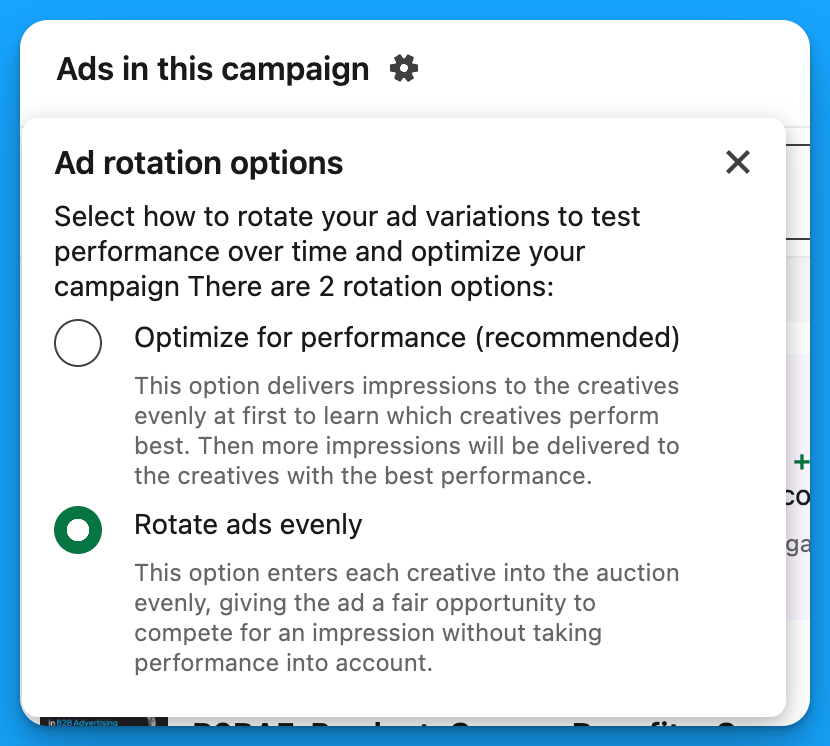
The thought process behind this is you want to understand which ad will perform the best by receiving enough budget for proper testing.
Unfortunately if you start with optimising for performance LinkedIn will prematurely assign 40-50% of your budget to one variation of ad while the others only receive what’s remaining.
In order to avoid this, start with rotating ads evenly for the first 7-14 days when launching a new campaign to serve budget equally and then switch to optimise for performance.
Tip #7: Check your demographics report weekly
I’ve hinted at this multiple times across all these tips but it’s so important to driving a return on investment with LinkedIn Ads that it deserves to be its own tip.
You need to know what’s happening across your account.
Review your demographics report for:
- Ad performance
- Campaign performance
- Campaign group performance
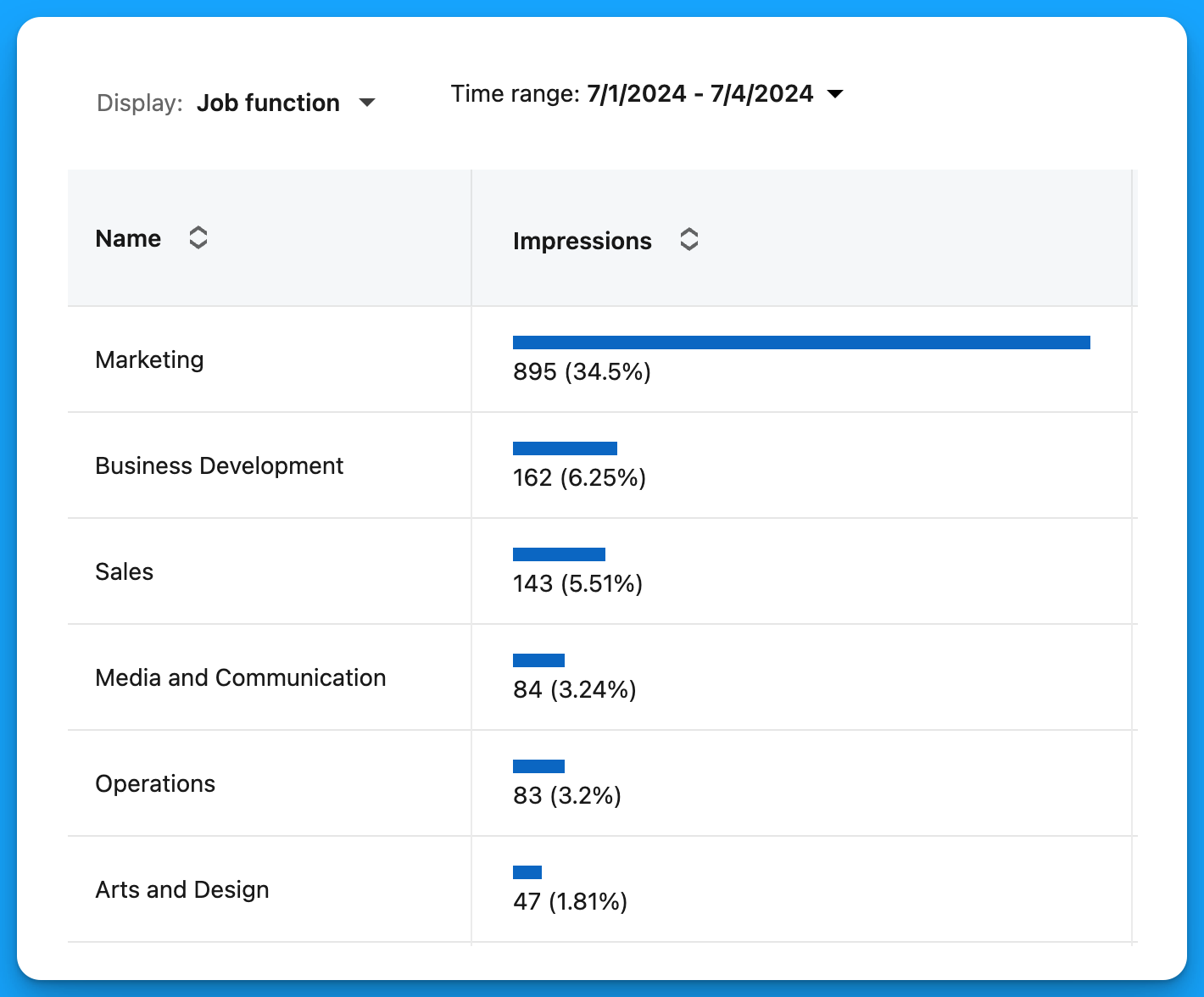
This will ensure your budget is going towards reaching the right people and companies.
Pro tip:
LinkedIn has reporting minimums when using the demographics report in platform, get around this by using a third party data connector to push the data into G-Sheet or Looker.
Tip #8: Target mobile devices exclusively with 628 x 1200
LinkedIn has a 628x1200 image ad spec that allows you to only appear on mobile devices.
If you know that your audience performs well for you on mobile devices you can set up a campaign leveraging this specific image ad dimension to serve exclusively on LinkedIn mobile.
The same is true for targeting desktop devices with text or spotlight ads.
Learn more about your audiences device behaviour with Google Analytics 4:

Tip #9: Review your performance by device
You can review your performance in LinkedIn by clicking on Breakdown > Impression by Device Type
The AdConversion team analysed 10,000,000+ impressions and found:
- 85.1% of impressions serve on Mobile App
- 9.6% of impressions serve on Desktop Web
- 5.3% of impressions serve on Mobile Web
That’s 90.4% of total impressions serving on mobile devices! 🤯

Pro tip:
Use the LinkedIn Ads preview to see what your ad will look like when displayed on mobile and optimise your copy to best fit this device over desktop.
Tip #10: Use LinkedIn’s bulk import and export feature
This tip is one that even my most savvy marketing friends aren’t aware of.
Changing bids, and creating campaigns on LinkedIn is a REAL pain.
You don’t need to suffer this pain and instead can use LinkedIn’s bulk import and export feature.
You can simply just export your ads, campaigns, or groups to make bulk changes.
Voila, a task that would take hours has been cut down into minutes.
Learn more about bulk actions in this article by LinkedIn.
Hope you found these 10 tips valuable! 👏
Implement the ones that resonate most with you to improve your ROI from LinkedIn Ads.
Connect with me on LinkedIn, if you have any questions or want to connect!
Master B2B LinkedIn Ads with these 3 Free Courses:
If you want to become a LinkedIn Ads pro, check out my free B2B LinkedIn Ads courses, where you'll learn how to launch, optimize, and scale your campaigns to drive pipeline and revenue.

Here's what you'll learn in each course:
⚙️ B2B LinkedIn Ads 101 - The Ultimate Crash Course for New LinkedIn Advertisers
- Foundations For LinkedIn Ads Success
- Measurement: Tracking & Key Principles
- Targeting: Reaching Your Dream Buyers
- Ads: Mastering The 9 Ad Formats
🎯 B2B LinkedIn Ads 102 - The Blueprint for LinkedIn Ads Optimization
- Monitoring: How To Spot Performance Trends
- Auditing: How To Find The Darlings You Need To Kill
- Reporting: How To Transform Data Into Insights
- Optimization: How To Make Your LinkedIn Ads Profitable
🚀 B2B LinkedIn Ads 103 - Advanced Scaling Strategies From $25M In Ad Spend
- Concepts of Scaling
- Divide and Conquer
- Learnings From $25M+ In LinkedIn Ad Spend
Click Here to Join 1,000+ B2B Marketers Today and start leveling up your advertising skill set.
Takes < 90 seconds to sign up (seriously we timed it 😂)
People Also Ask
How can I effectively research my customers to improve LinkedIn Ads targeting?
To gain a deeper understanding of your customers, watch 3-5 sales calls recommended by your Head of Sales. Analyze how the sales team presents the product and ensure your messaging aligns. Additionally, use tools like ChatGPT to develop content matrices and empathy maps from call transcripts, summarizing top pain points of your prospects. 
What strategies can I use to distribute and repurpose content for LinkedIn Ads?
Distribute valuable content that addresses your audience’s pain points and showcases your expertise. Repurpose high-performing content into different formats, such as turning a blog post into a video or infographic, to reach a broader audience and maintain engagement. 
How can I leverage Subject Matter Experts (SMEs) in my LinkedIn Ads?
Utilize your SMEs for thought leader ads by having them post insightful content on their personal profiles. Promote these posts through your company’s LinkedIn Ads to build credibility and trust with your target audience, positioning your brand as an industry leader. 
What tracking setup is recommended for LinkedIn Ads?
Implement a comprehensive tracking system that combines LinkedIn’s Insight Tag with your CRM and marketing automation platforms. This setup enables accurate tracking of leads and conversions, providing valuable data to optimize your campaigns effectively. 
Why is a long-term commitment important for LinkedIn Ads success?
Committing to at least six months allows sufficient time to test, learn, and optimize your LinkedIn Ads campaigns. This duration helps in understanding what resonates with your audience and enables continuous improvement, leading to better results over time.

4 Unique LinkedIn Ad Strategies To Drive More Webinar Registrations
Webinars can be amazing generators of pipeline and revenue.
They allow you to demo different use cases of your product, highlight success stories, and start actual conversations with your ICP.
But it’s hard to get prospects interested when you’re competing against a million different ads popping up in their feed.
Below are 4 unique LinkedIn ad strategies that I like to use to stand out and generate more registrations👇
TABLE OF CONTENTS:
- Strategy #1: Leverage your thought leaders
- Strategy #2: Boost high-performing social media content
- Strategy #3: Create a LinkedIn event
- Strategy #4: Use incentives
Strategy #1: Leverage your thought leaders
Ask your thought leaders who are participating in the webinar (from your company & other companies) if they’d feel comfortable posting about it.
If the answer is yes, draft a sample post for each of your thought leaders so that they don’t have to start with a blank page.
Ideally, they should post a couple weeks prior to the webinar date. After 4 or 5 days (once the organic reach has died down), you can boost the post to your ICP.
Example from DoWhatWorks
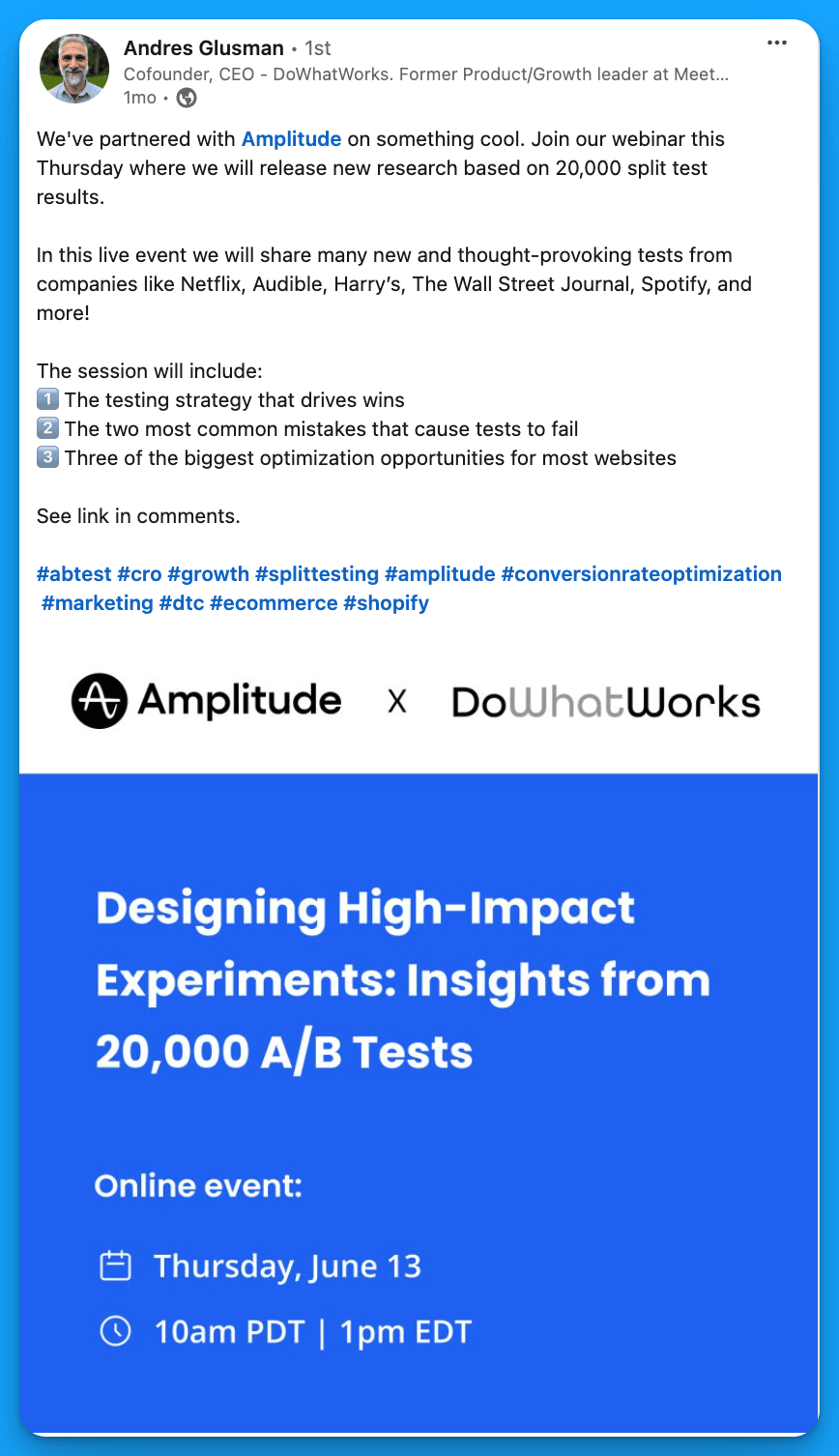
Strategy #2: Boost high-performing social media content
If your social media team posts about the webinar and it performs well organically, consider boosting this content and running it as an ad (instead of creating an ad from scratch). The benefit of boosting already high-performing content is the added social proof – prospects will take a closer look if a promoted post has tons of engagement.
Example from Uberflip
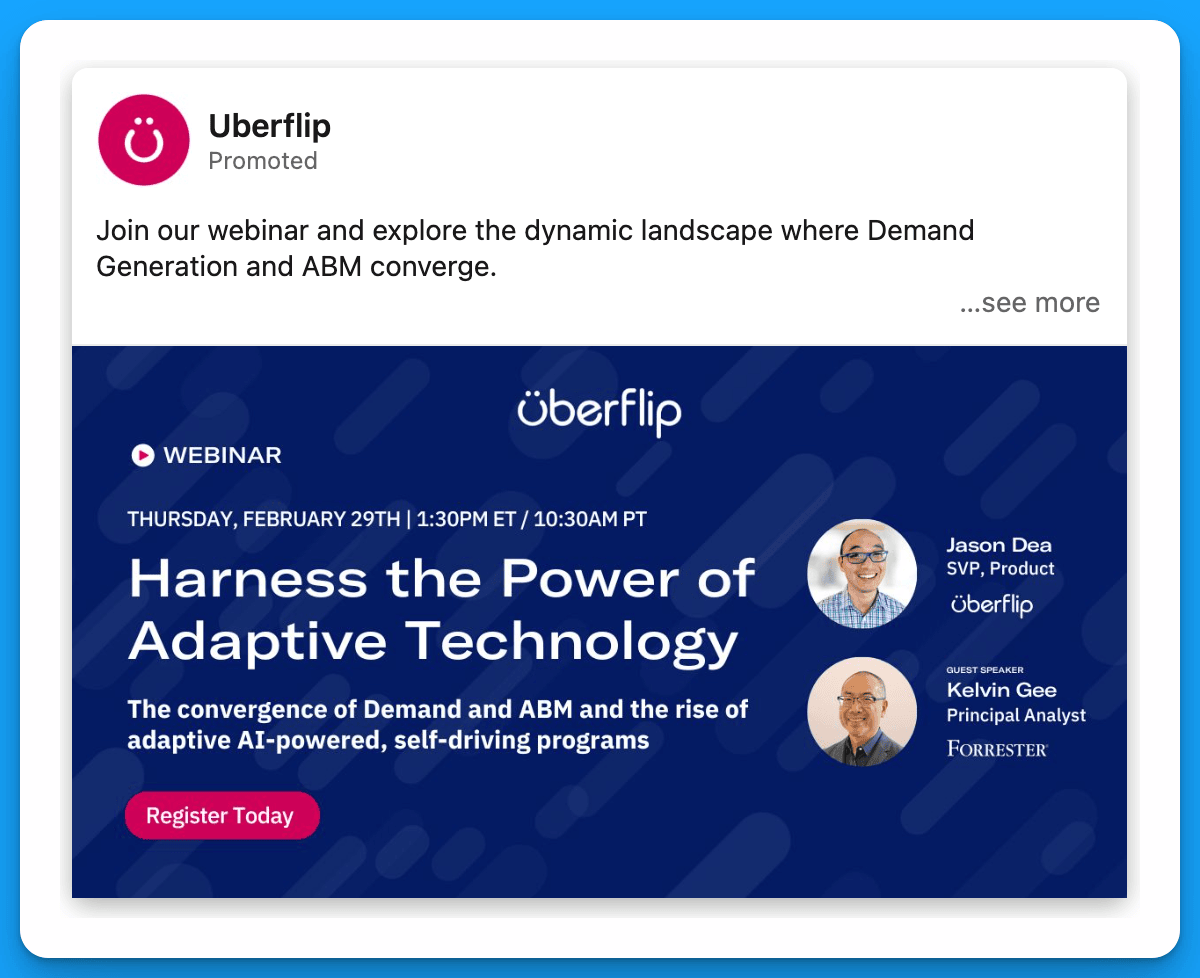
Strategy #3: Create a LinkedIn event
Most webinar ads take prospects to an external landing page, where they have to fill out a form to register. Although this can work well, a great alternative is to create a LinkedIn event (where people can sign up directly on the LinkedIn platform) and promote this event as an ad.
The main advantages of this approach are:
a) simplified registration (only takes a few clicks)
b) added social proof (event ads show how many people have already registered)
Example from Make

Strategy #4: Use incentives
A lot of companies use incentives for demo request offers, but few are using incentives to promote their webinars.
Give prospects an extra reason to register. Maybe by joining they’ll enter a raffle, get a free coffee, or gain access to certain templates.
Example from ZoomInfo

Final Recommendations
In addition to testing out the strategies above, here are a few final tips to maximize the ROI of your webinar program:
- If you’re having trouble getting webinar registrations on your landing page, consider switching to native lead gen forms to minimize friction.
- Don’t just promote your webinar to a cold audience. Think about other groups of people that might be interested in the content (i.e. retargeting audiences, open opportunities, churned customers, closed lost companies, previous webinar attendees, etc.)
- If you’re getting started, try different types of webinars to see what resonates most with your audience (and double down on whatever works)
If you want more tips around event promotion check out this article by Kirk Deis.
Hope you found this article insightful!
Connect with me on LinkedIn, and reach out with any questions.
Master B2B LinkedIn Ads with these 3 Free Courses:
If you want to become a LinkedIn Ads pro, check out our free B2B LinkedIn Ads courses, where you'll learn how to launch, optimize, and scale your campaigns to drive pipeline and revenue.

Here's what you'll learn in each course:
⚙️ B2B LinkedIn Ads 101 - The Ultimate Crash Course for New LinkedIn Advertisers
- Foundations For LinkedIn Ads Success
- Measurement: Tracking & Key Principles
- Targeting: Reaching Your Dream Buyers
- Ads: Mastering The 9 Ad Formats
🎯 B2B LinkedIn Ads 102 - The Blueprint for LinkedIn Ads Optimization
- Monitoring: How To Spot Performance Trends
- Auditing: How To Find The Darlings You Need To Kill
- Reporting: How To Transform Data Into Insights
- Optimization: How To Make Your LinkedIn Ads Profitable
🚀 B2B LinkedIn Ads 103 - Advanced Scaling Strategies From $25M In Ad Spend
- Concepts of Scaling
- Divide and Conquer
- Learnings From $25M+ In LinkedIn Ad Spend
Click Here to Join 1,000+ B2B Marketers Today and start leveling up your advertising skill set.
Takes < 90 seconds to sign up (seriously we timed it 😂)
People Also Ask
How can leveraging thought leaders enhance my LinkedIn Ads for webinars?
Encourage thought leaders participating in your webinar to post about it on their personal profiles. Provide them with sample posts to simplify the process. After the organic reach declines, boost these posts to your Ideal Customer Profile (ICP) to increase visibility and credibility. 
What is the benefit of boosting high-performing social media content for webinar promotion?
If your social media team shares a webinar post that performs well organically, consider boosting it as an ad. This approach leverages existing engagement and social proof, making the promoted post more appealing to prospects. 
How can creating a LinkedIn event aid in webinar registrations?
Instead of directing prospects to an external landing page, create a LinkedIn event where users can register directly on the platform. This method simplifies the registration process and displays the number of attendees, adding social proof. 
What are the best practices for targeting the right audience for webinar promotions on LinkedIn?
Leverage LinkedIn’s advanced targeting options to focus on specific industries, job titles, company sizes, and geographic locations that align with your ideal webinar attendees. Utilizing these parameters ensures your ads reach professionals who are most likely to be interested in your content.
How can I integrate LinkedIn ads with other marketing channels to maximize webinar attendance?
Coordinate your LinkedIn ad campaigns with email marketing, social media promotions, and content marketing efforts to create a cohesive promotional strategy. Consistent messaging across channels reinforces your webinar’s value and broadens its reach.
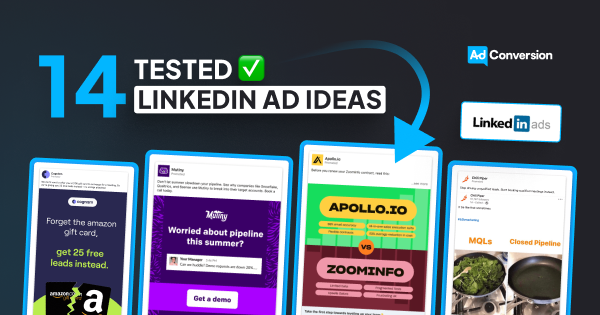
14 Tested LinkedIn Ad Ideas to Scale Demos
Getting demos isn’t easy, especially in B2B SaaS, with long sales cycles, lots of decision makers, and tons of competition.
In this article, I’ll break down the top 14 LinkedIn ads strategies you can use to break through the noise and capture existing demand.
(Irrelevant of order all ideas could be worth testing)
TABLE OF CONTENTS:
#2: Name the top companies you work with
#3: Demonstrate why you’re better than competitors
#4: Highlight integrations with partner technologies
#7: Try hyper-personalized messaging
#10: Show how much better life would be with your product
#11: Test ads in different languages
#12: Announce a new product update
#13: List the features that your ICP would be most interested in
#1: Use testimonials
Testimonials are one of the most effective ways to build trust and get prospects who are on the fence to take the next step.
Example 1: Chili Piper
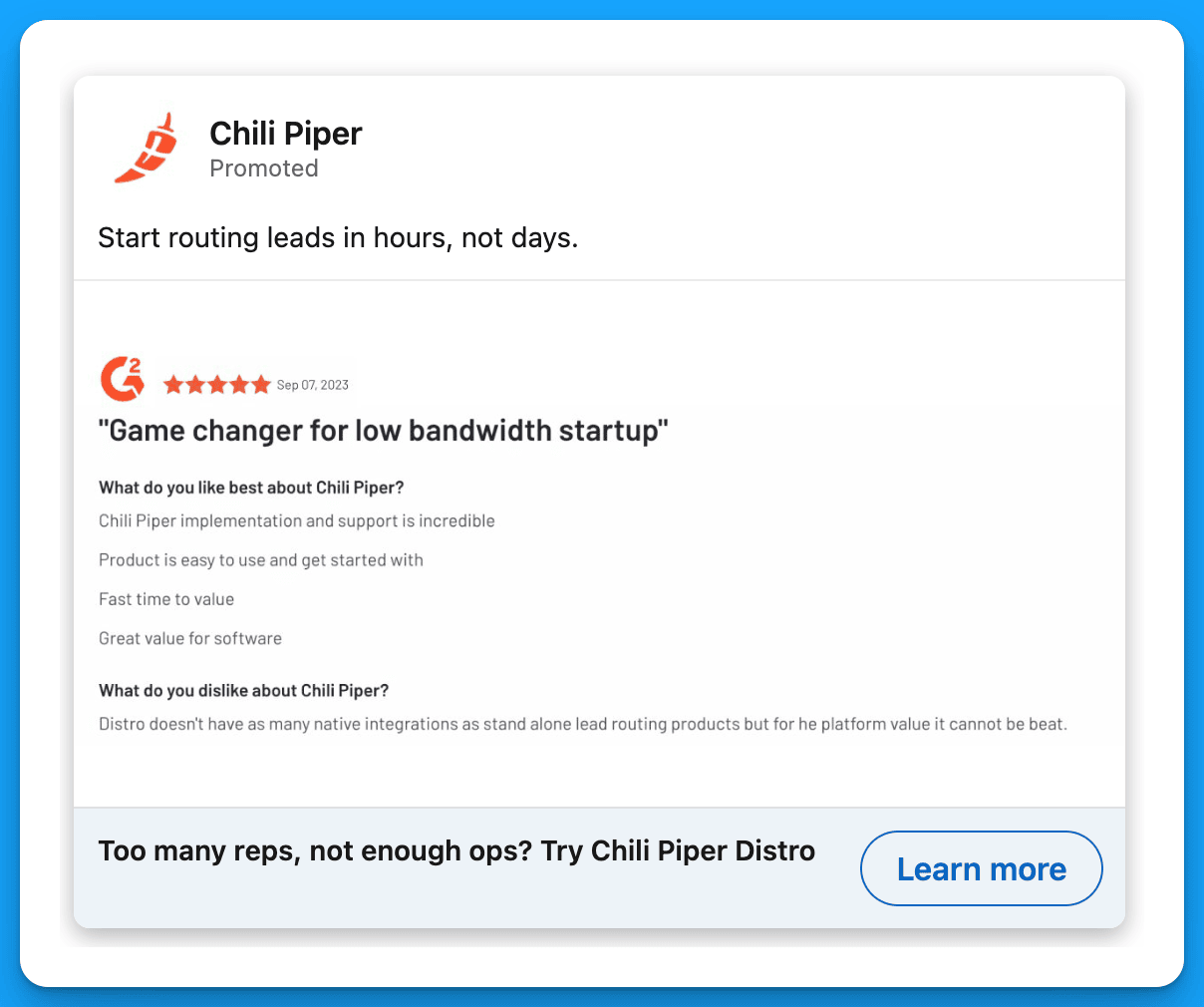
Example 2: Sendoso
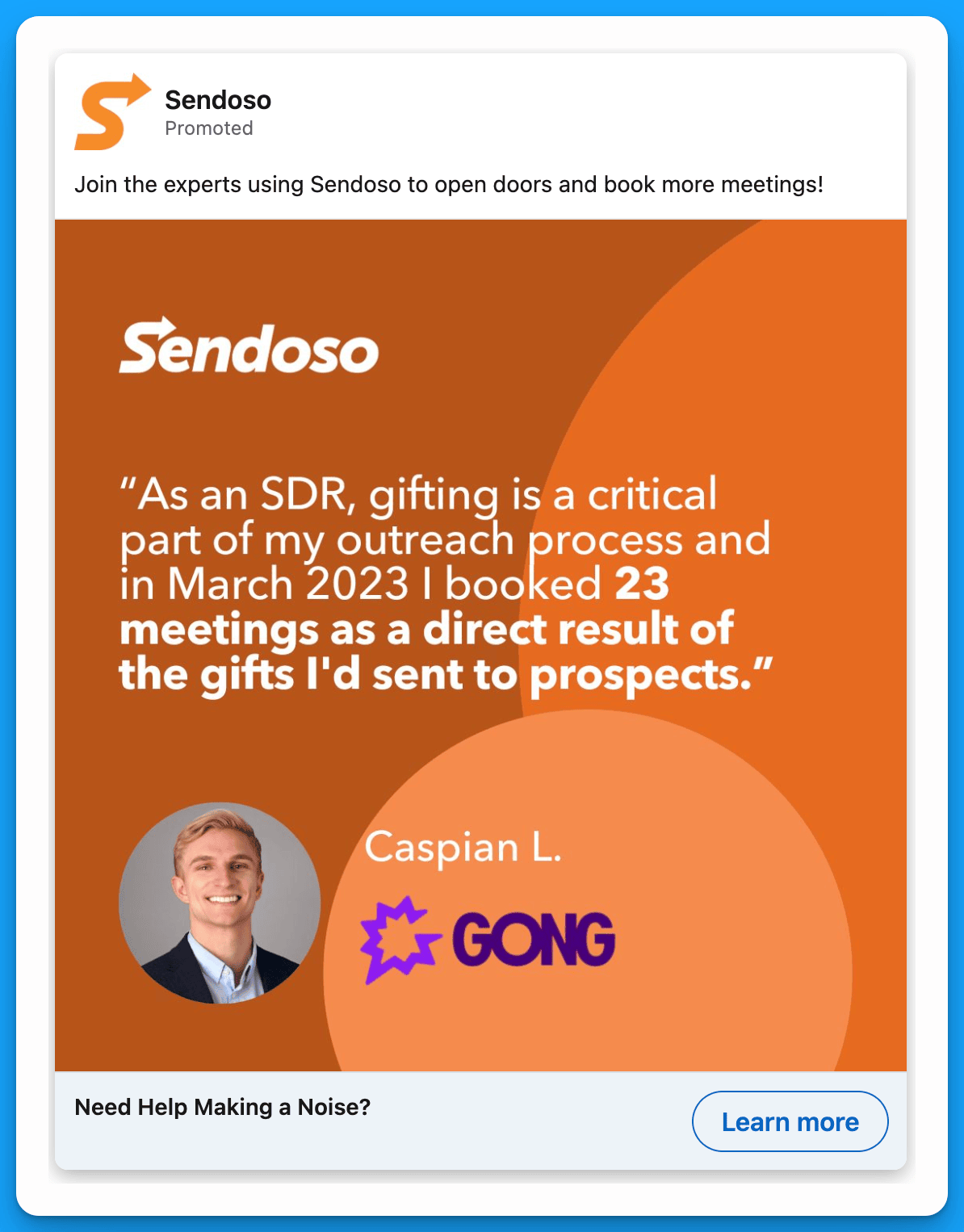
#2: Name the top companies you work with
By highlighting well-known companies that already work with you, you can gain the trust of senior leaders much faster and accelerate the sales process.
Example 1: MarketerHire
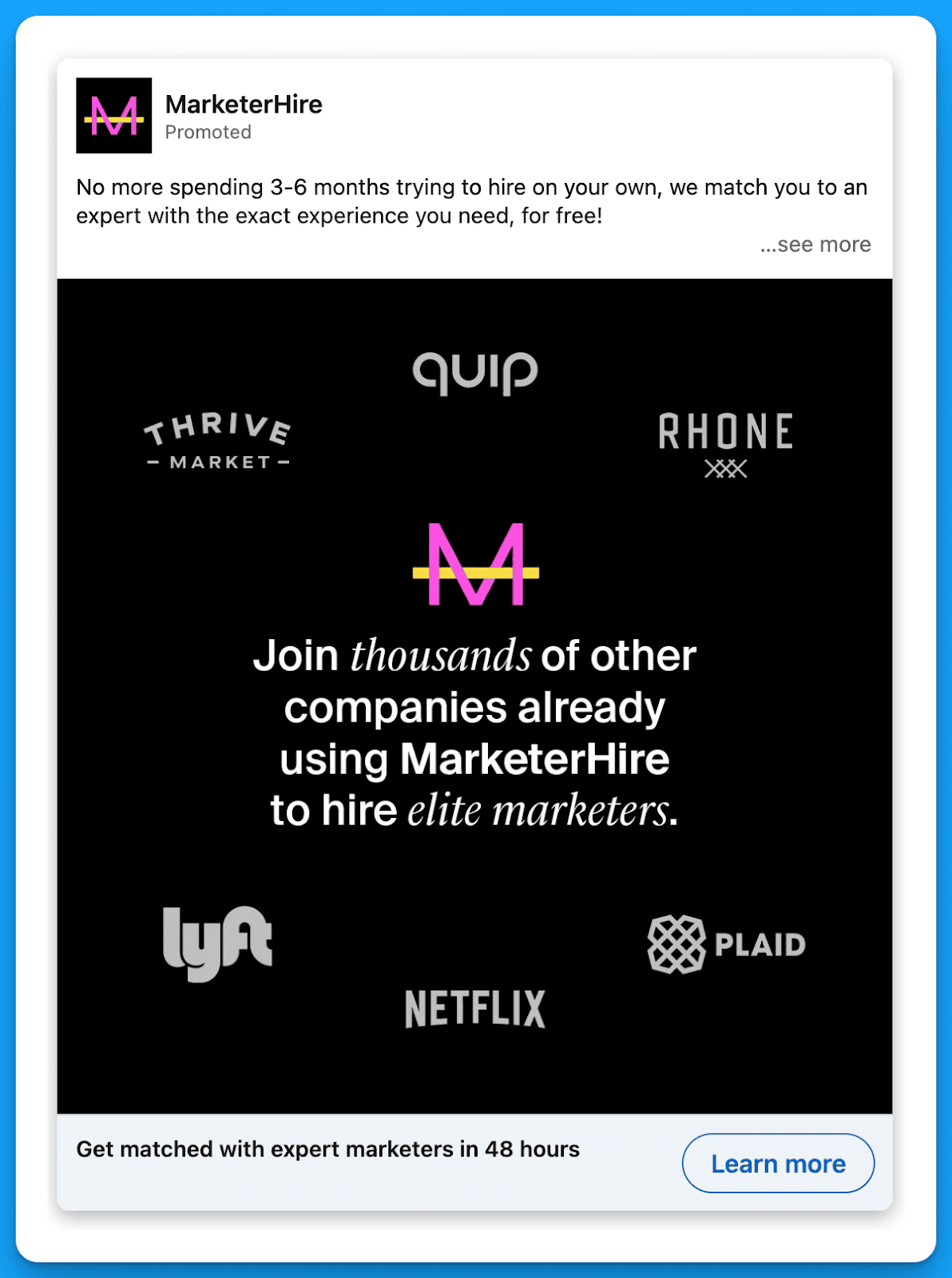
Example 2: Mutiny
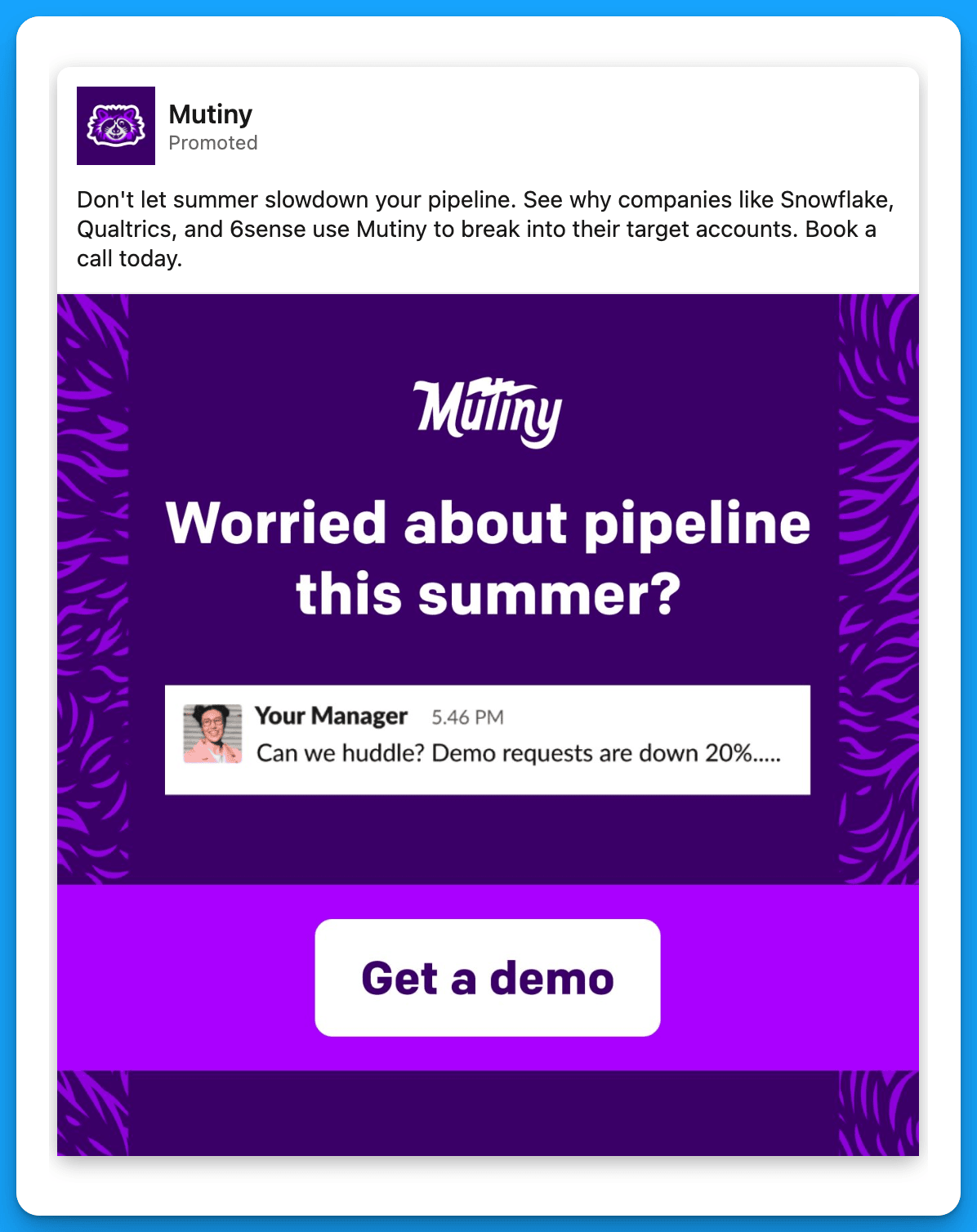
#3: Demonstrate why you’re better than competitors
This approach is powerful, especially when you target prospects who are currently using your competitors. Since they’re already in-market, if they’re frustrated with their current solution, they’ll likely end up switching over (or at least consider it).
Example 1: Apollo
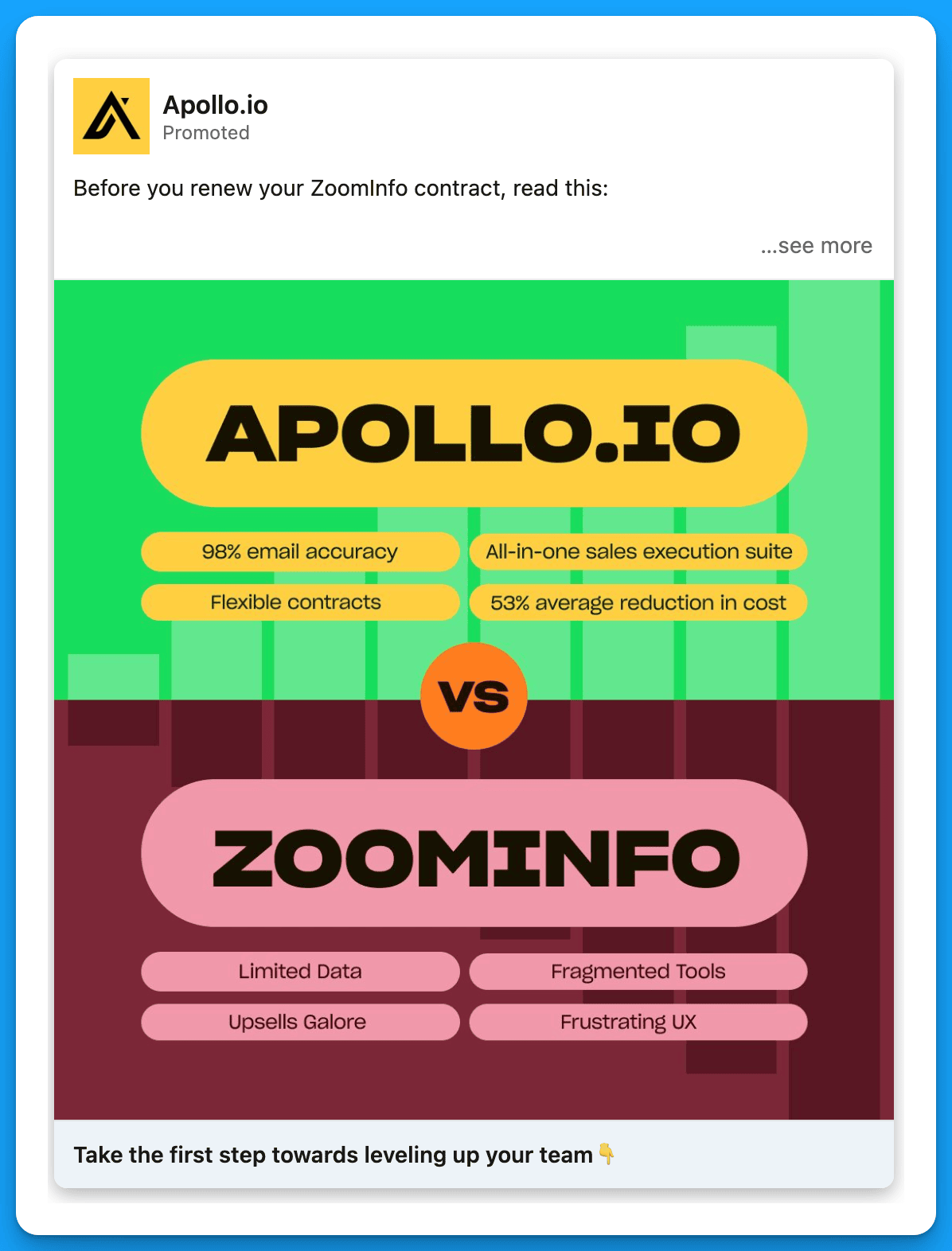
Example 2: Apollo

#4: Highlight integrations with partner technologies
This approach is particularly effective if you have a seamless integration with a well-known technology. Do you work well with HubSpot, Salesforce, Sales Nav, Wordpress, etc.? Target a list of companies within your ICP who are using the technology you integrate with, and show them why you’re the best choice.
Example 1: Typeform

Example 2: Typeform
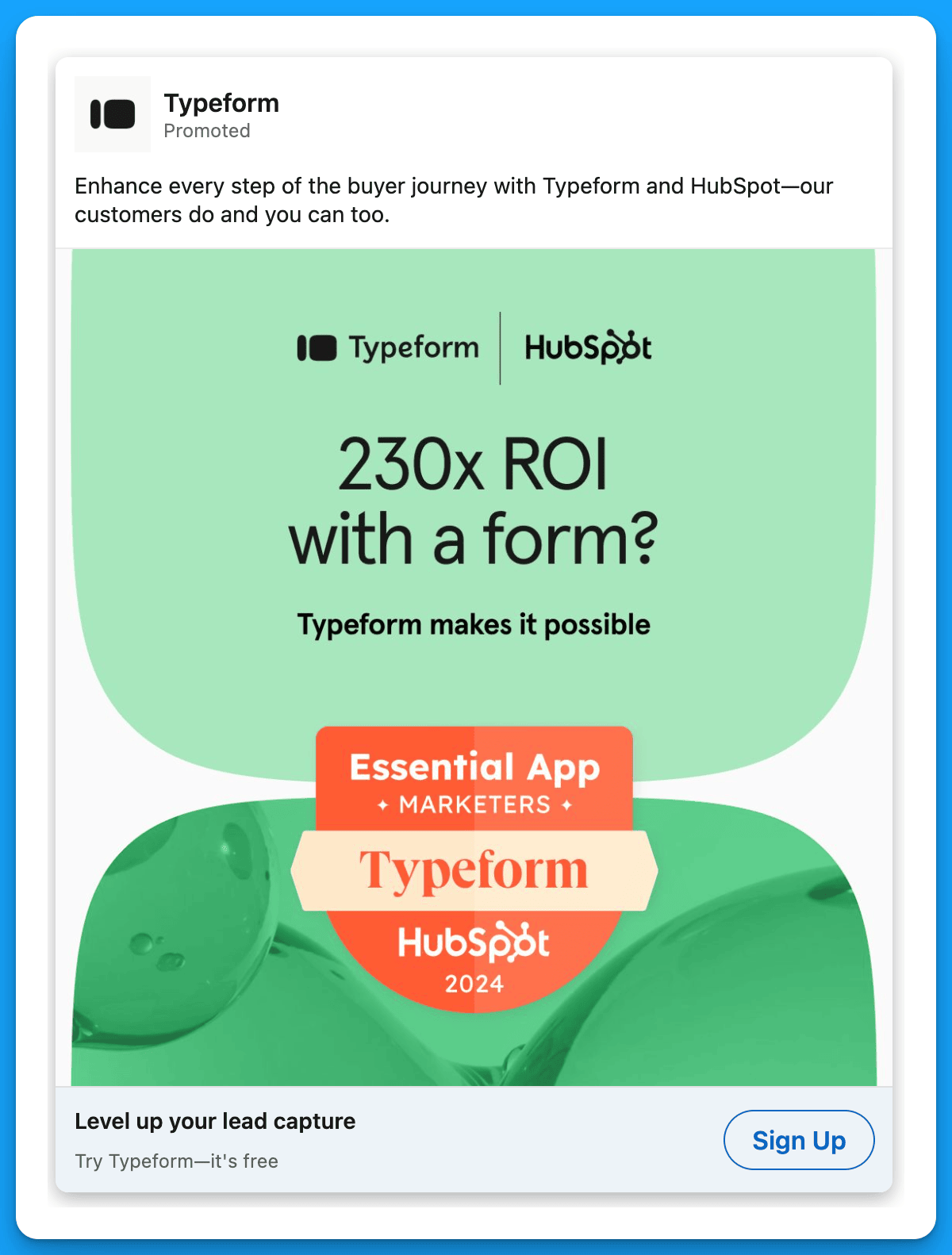
#5: Showcase your product
Many times, all prospects need to take the next step is to get a glimpse of your software. Also, this is an especially great approach because it sets the sales team up for success – when prospects jump on a demo call, they’ll already have some familiarity with the product.
Example 1: HockeyStack
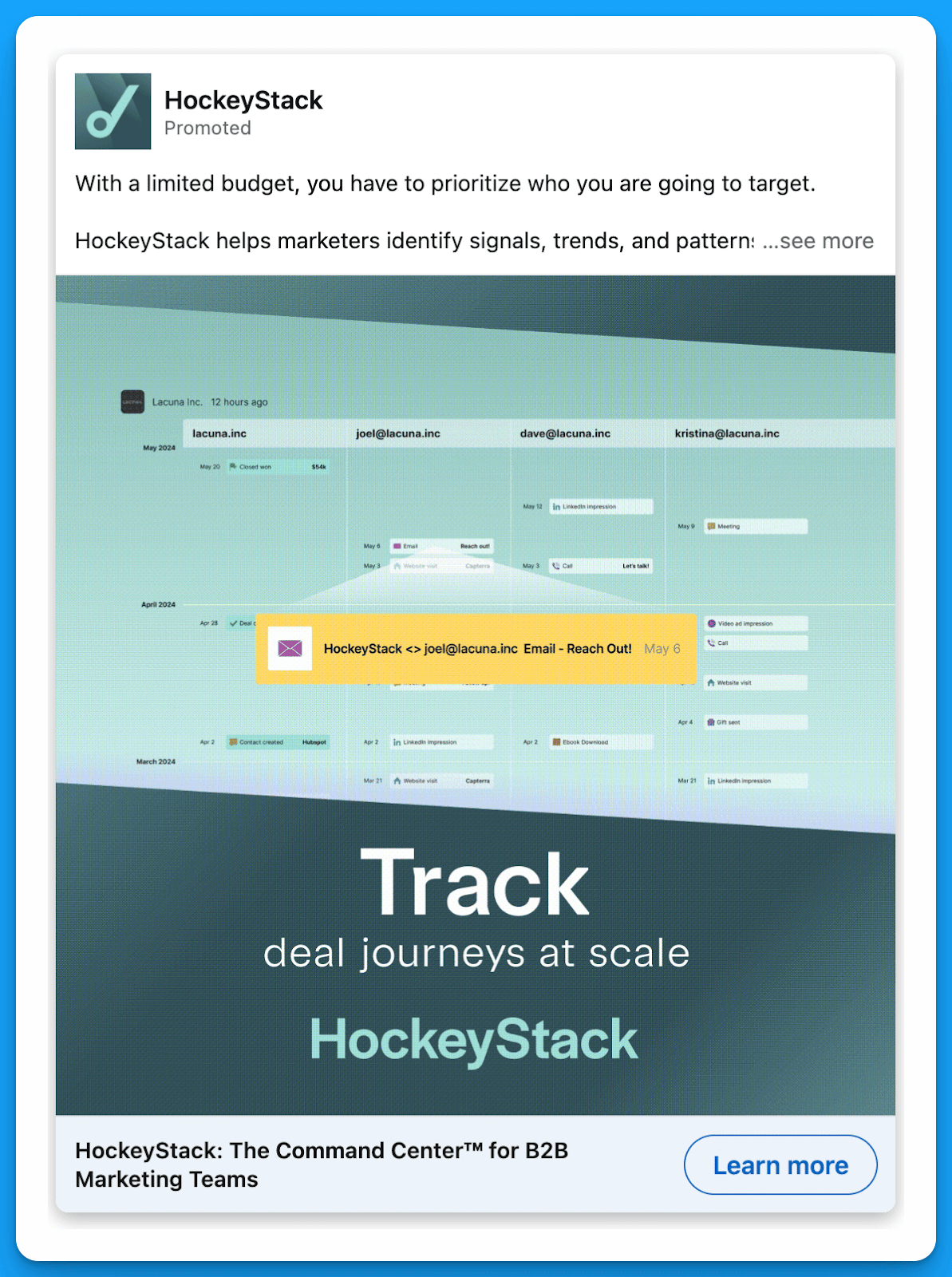
Example 2: Loxo
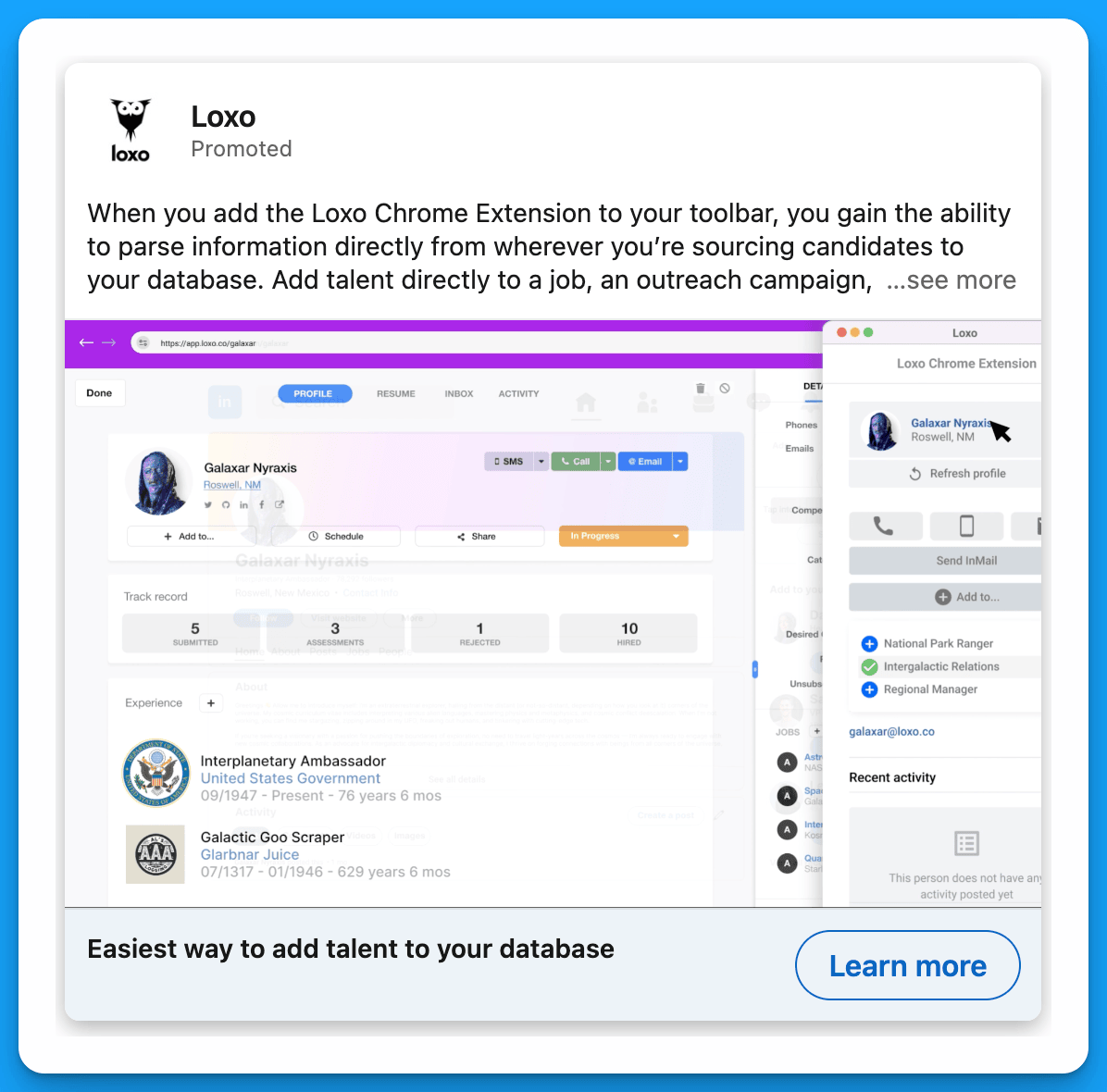
#6: Stand out with humor
B2B leaders are still people. Humor that’s relatable and clearly highlights a pain point works better than corporate jargon 99% of the time.
Example 1: Chili Piper

Example 2: Cognism

#7: Try hyper-personalized messaging
This approach, often referred to as 1:1 ABM, relies on extreme personalization. You specifically call out the company that you’re prospecting into, and maybe you take it a step further and create a personalized video or asset just for them. CTRs will be super high and even if prospects don’t convert on an initial touchpoint, you’ll make sales’s job significantly easier by generating awareness within a target account.
Example 1: UserGems

Example 2: HockeyStack
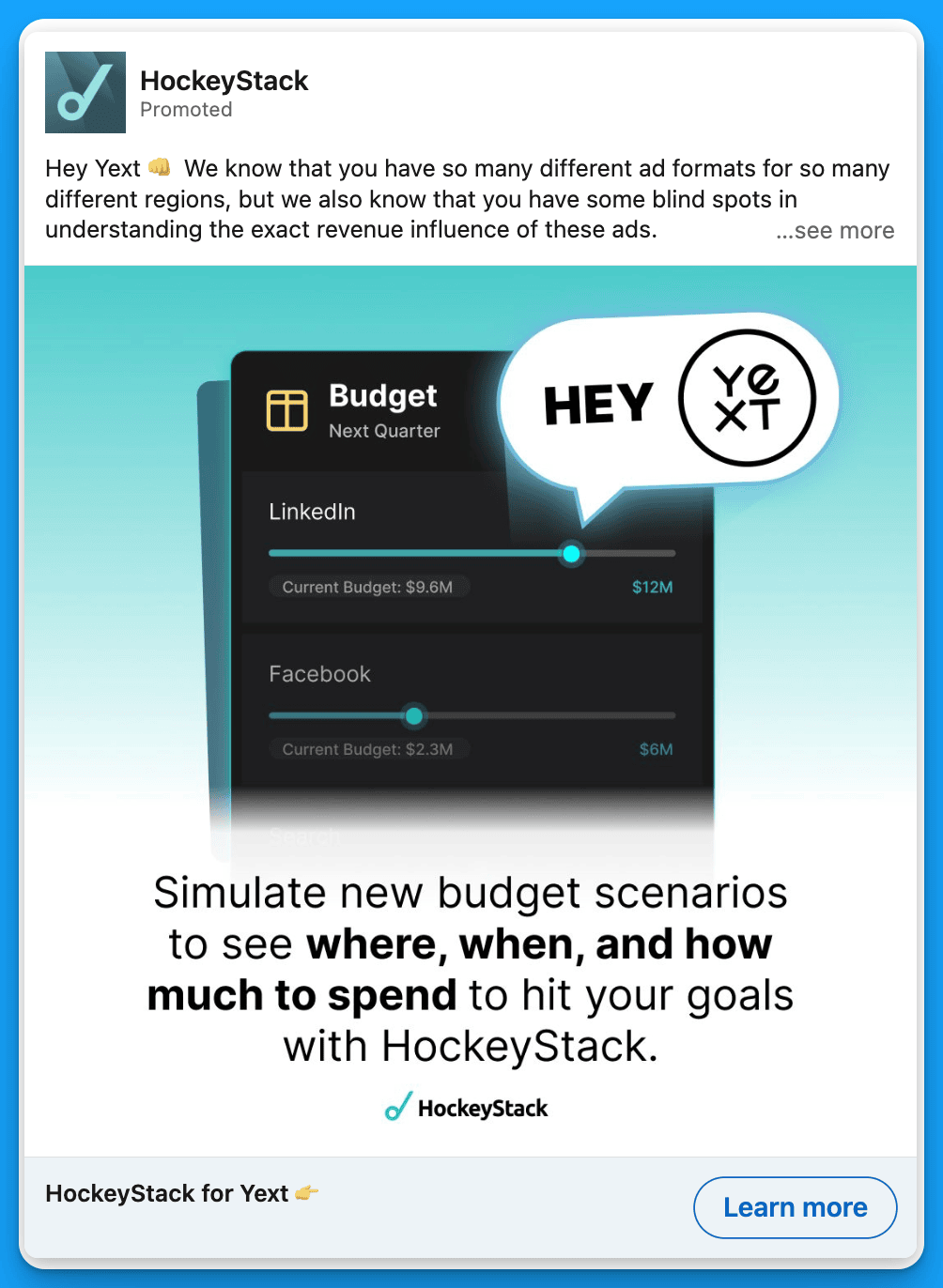
#8: Use statistics
This isn’t the flashiest or most exciting strategy, but it works. Numbers give prospects a sense of security that they’ll get a positive ROI if they invest.
Example 1: UserGems

Example 2: Lavender
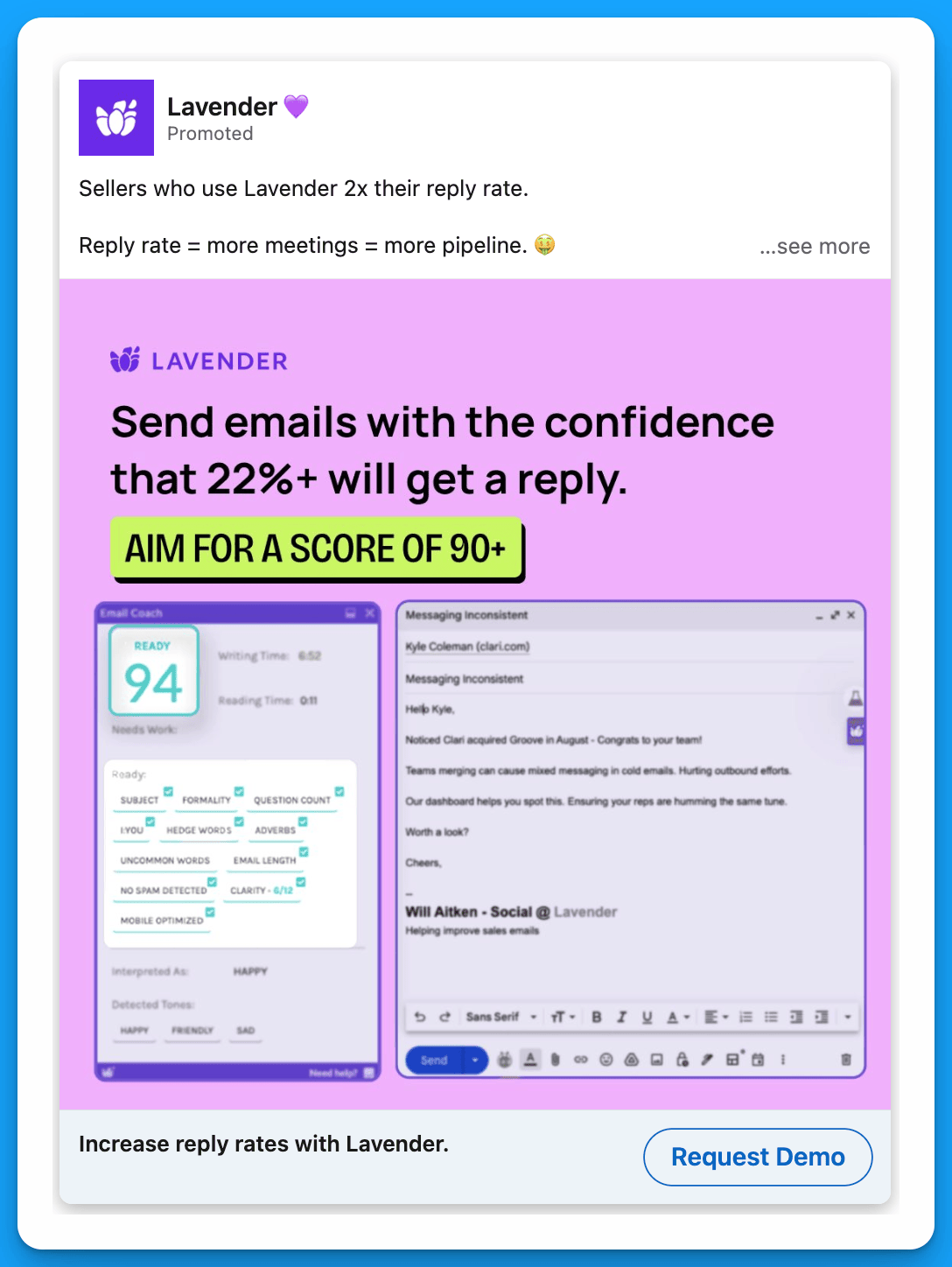
#9: Leverage Incentives
Incentives are controversial, which is understandable.
The concern is that by offering an incentive you lower the quality of your leads. But that’s only true if your targeting is weak. If it’s spot on, incentivized demo ads are amazing generators of pipeline and revenue – they serve as a tiny nudge to encourage leaders to find some time in their calendar.
Amazon or Doordash gift cards work well, but you can always get more creative with your offer.
Example 1: Metadata
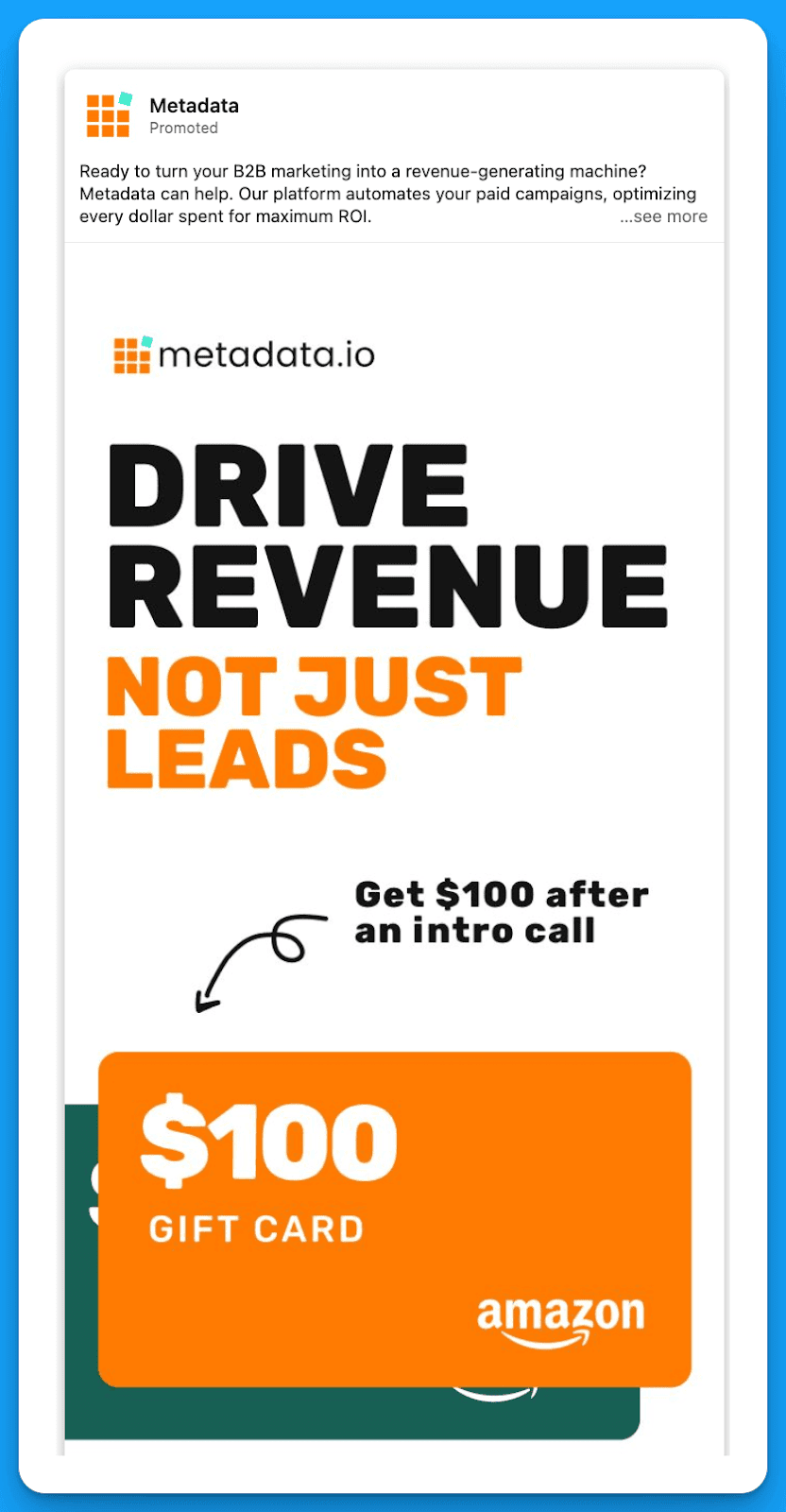
Example 2: Cognism

#10: Show how much better life would be with your product
This approach clearly emphasizes the pain point your product will solve, leading prospects to take action.
Example 1: Motion
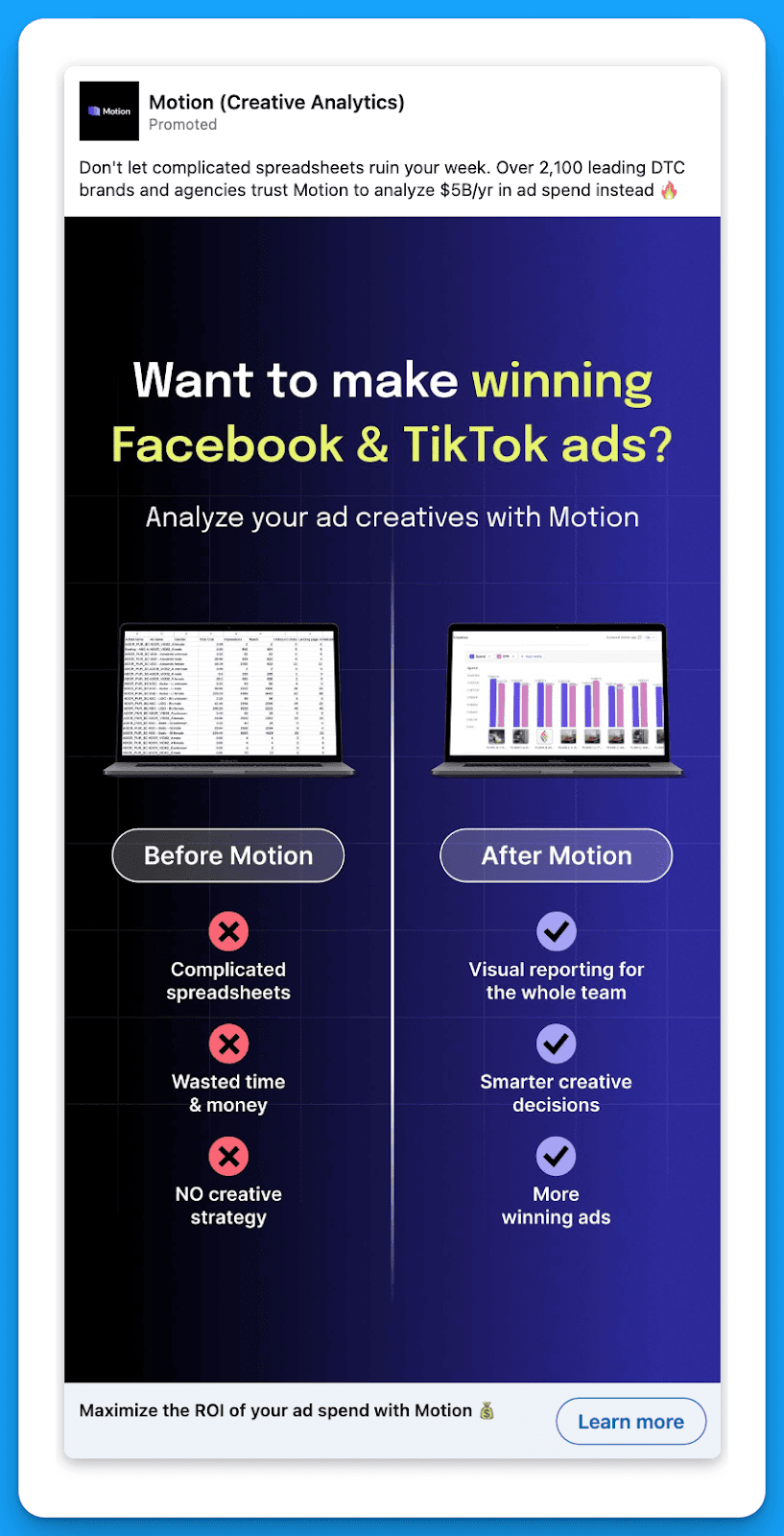
Example 2: Workvivo
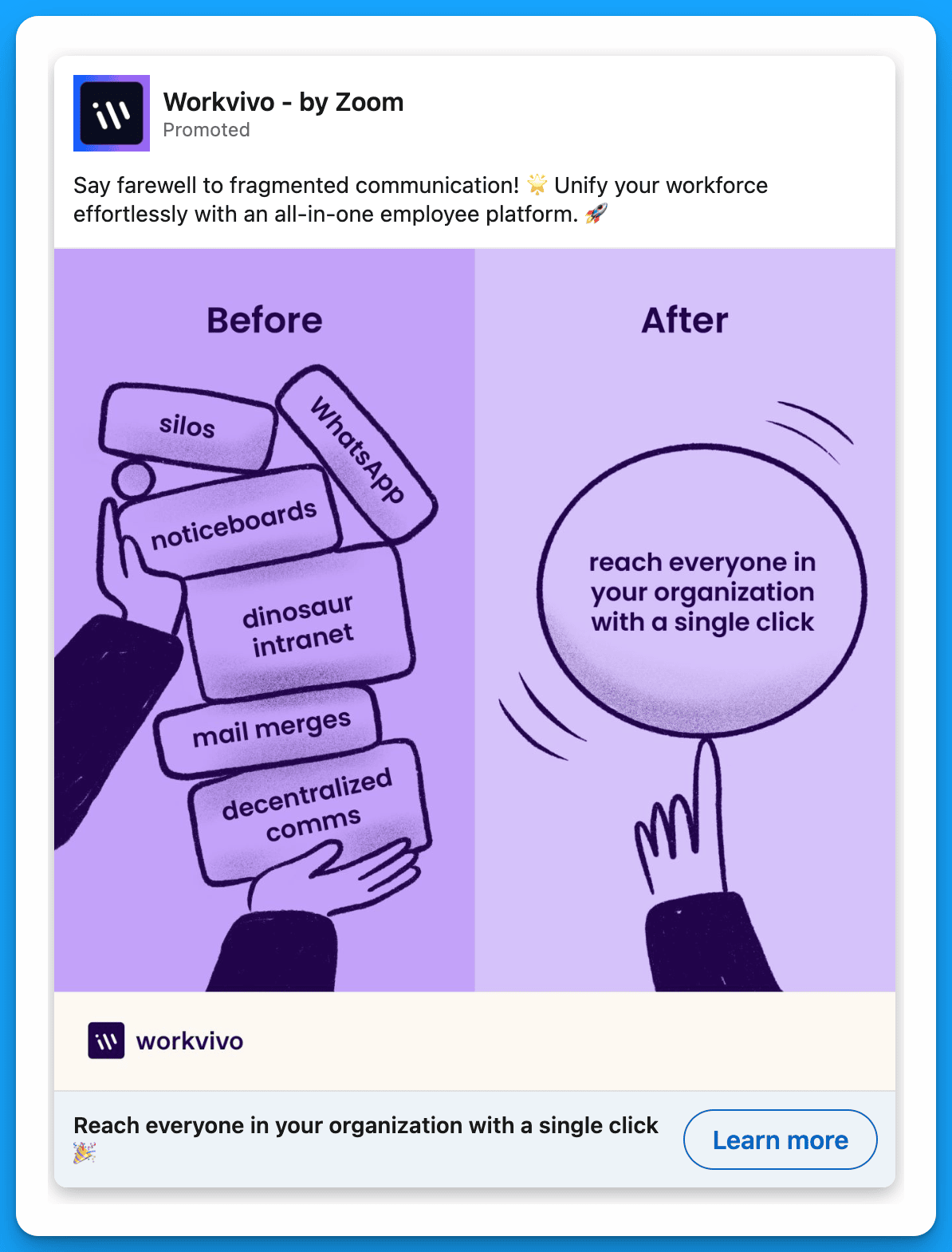
#11: Test ads in different languages
A lot of B2B SaaS companies are hyper-focused on North America, and their content for Latin America, EMEA, and APAC is just an afterthought. Running high quality ads in the language of the specific region you’re targeting can be a game changer as far as driving pipeline and revenue.
Bonus: If you take into account regional differences in consumer behavior and product usage when creating ads for different regions, your content will end up resonating even more.
Example 1: Pandadoc
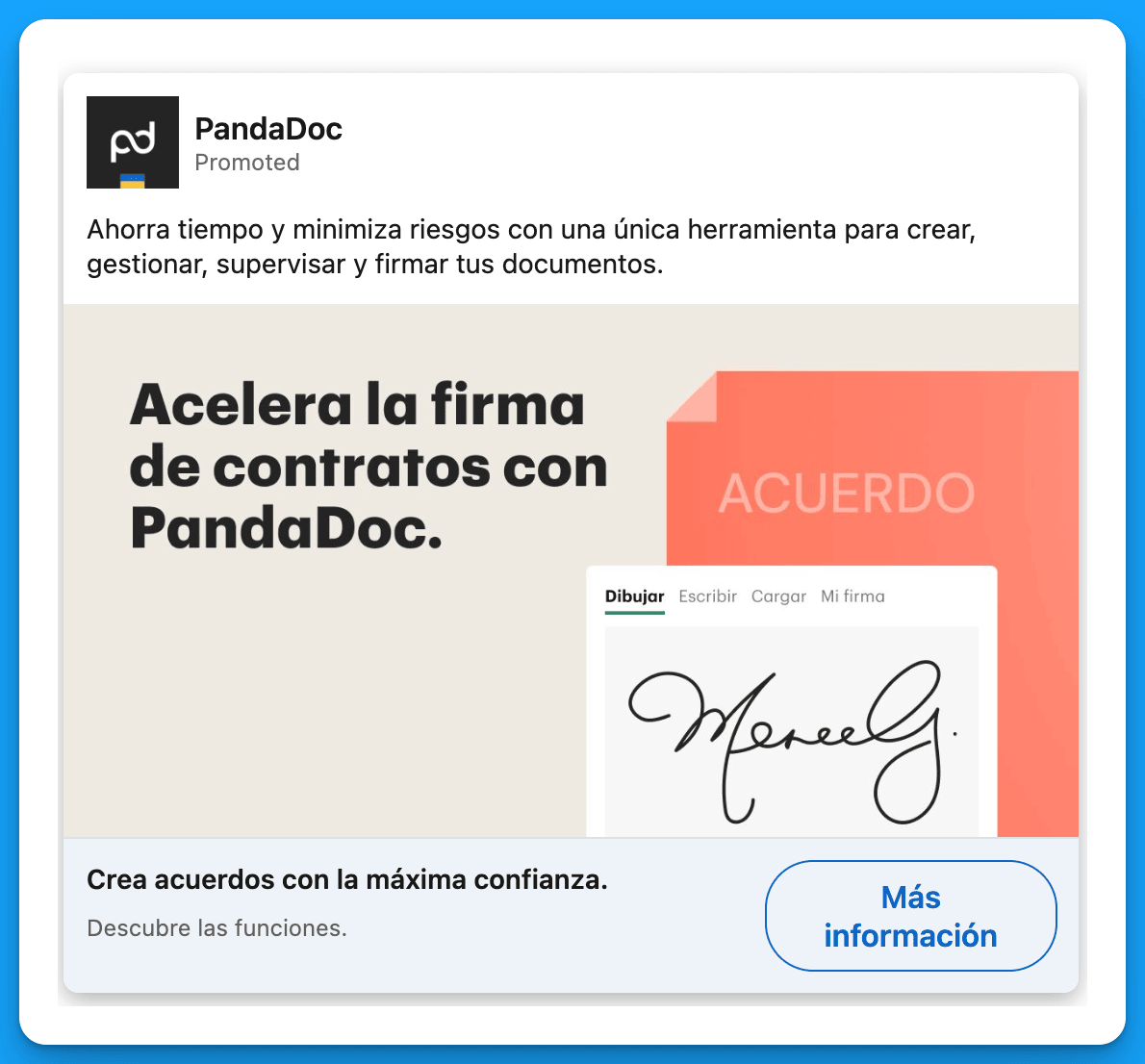
Example 2: Miro
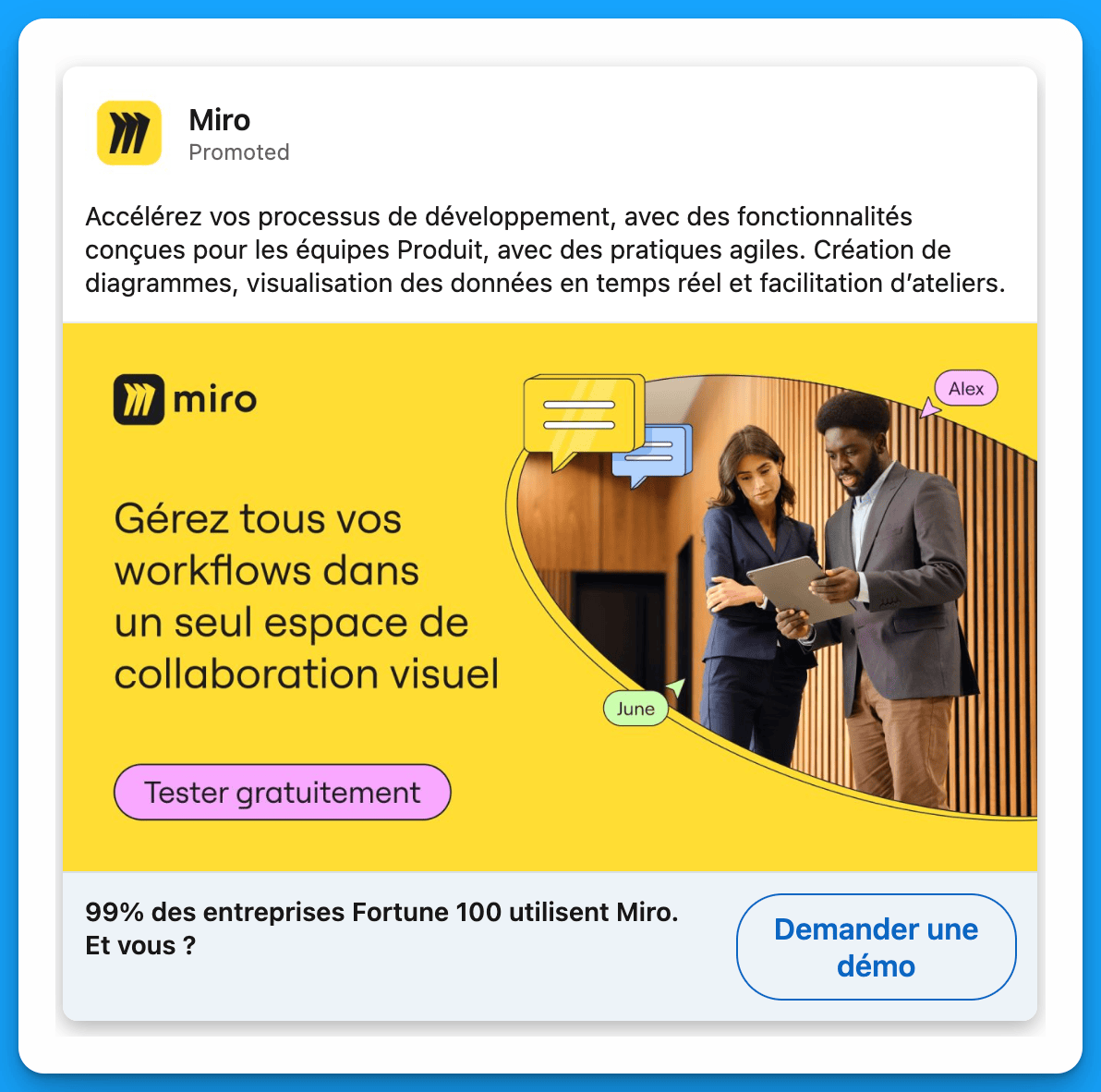
#12: Announce a new product update
This is a great way to re-engage people who may have considered your solution in the past but weren’t fully convinced. By showing prospects how much better your product is after the updates, you can convince them to take the next step and request a demo.
Example 1: Zoominfo

#13: List the features that your ICP would be most interested in
As marketers, we’re always told to focus on pain points instead of features. But listing your top features can help prospects fully understand how powerful your product is, encouraging them to request a demo.
Example 1: Workvivo
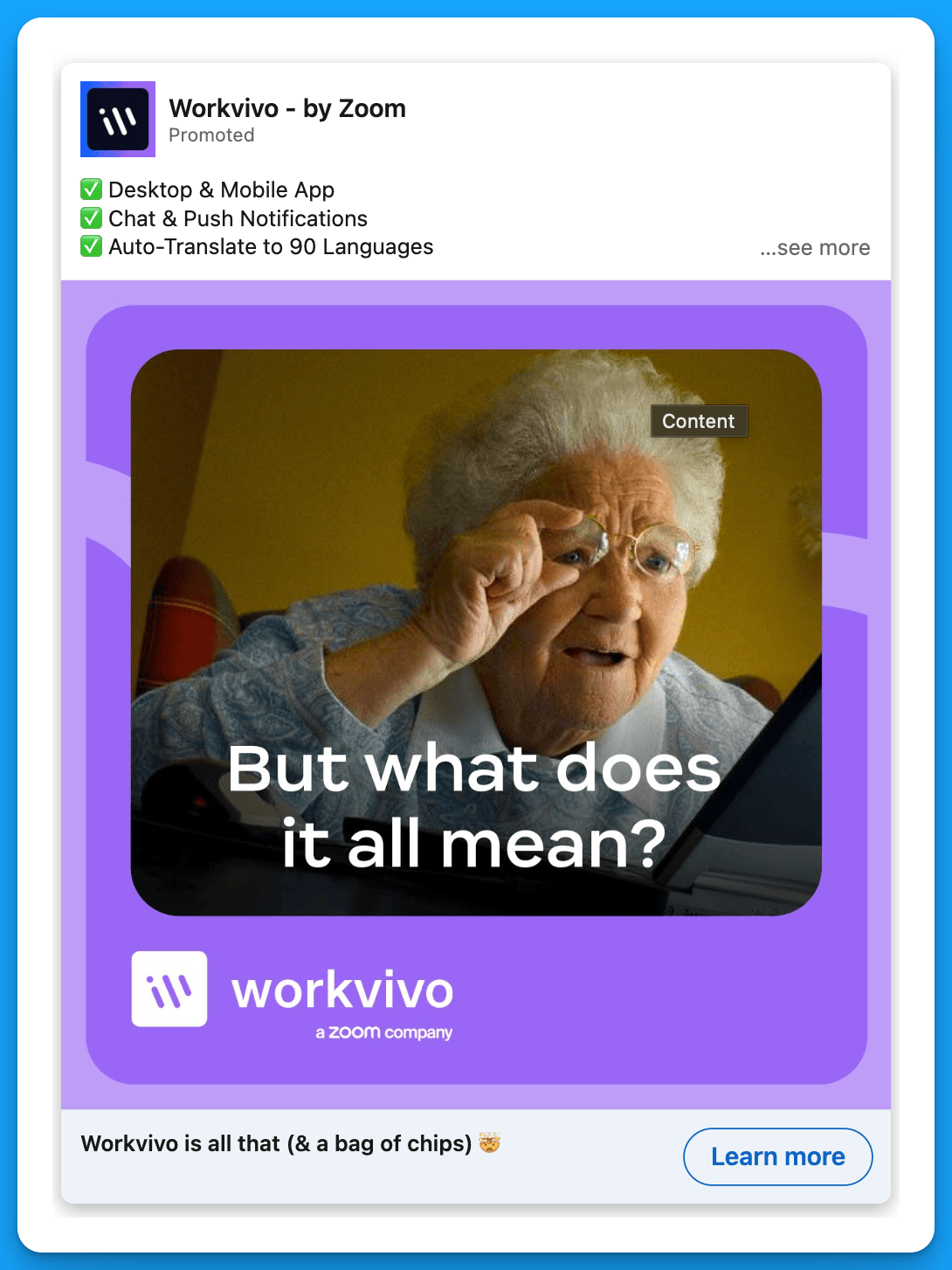
#14: Host a live demo
Promoting a live demo is a great way to get qualified prospects to see your product without having to go through the traditional (and higher commitment) demo process.
Prospects who are interested in your product may not be ready to talk to the sales team right away – a live demo can serve as a bridge, moving them further down the funnel.
Example 1: Metadata
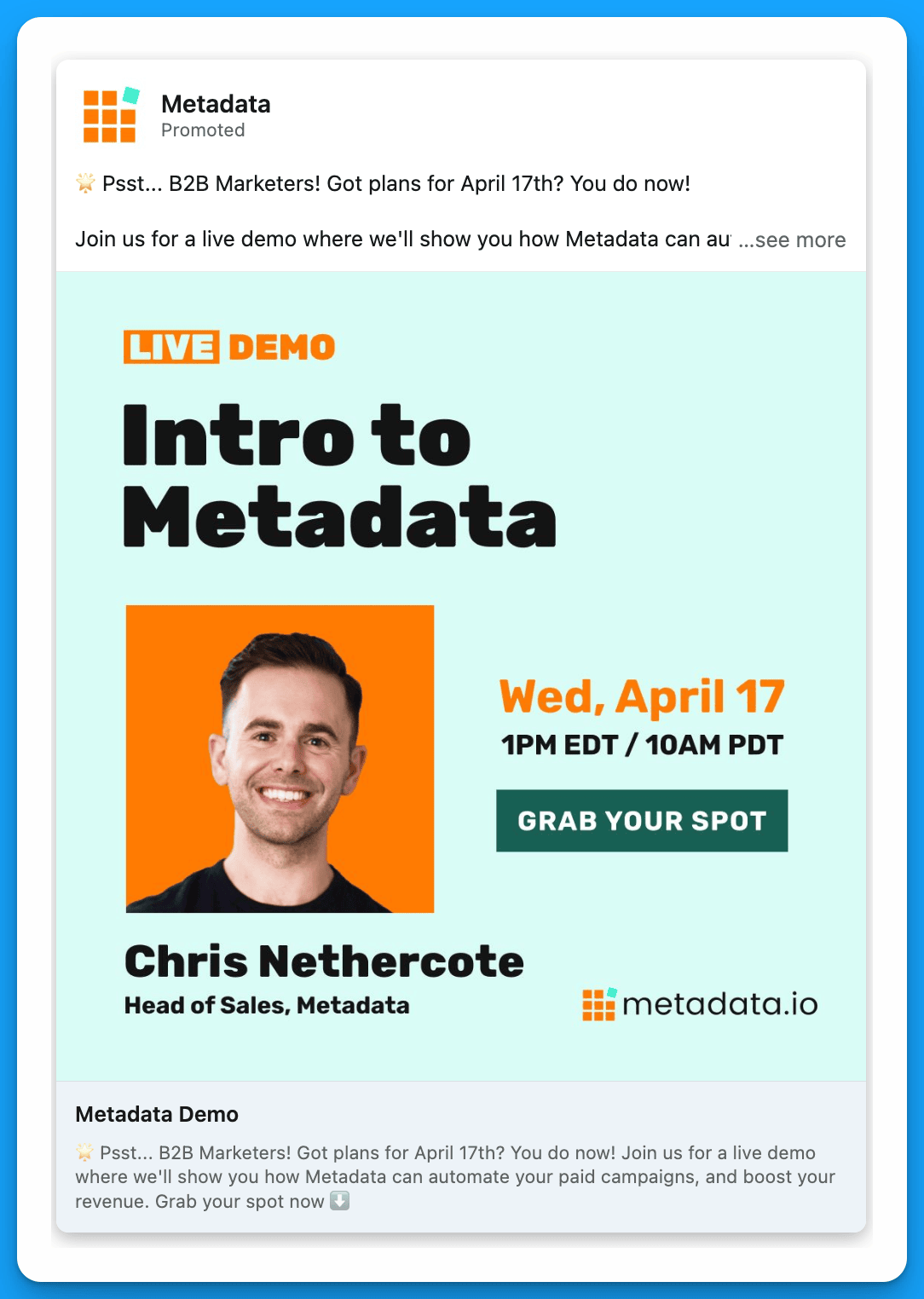
Example 2: Motion

Final Recommendations
If you’re trying to drive more demos, in addition to testing out these capture strategies, I recommend doing a comprehensive audit of your audiences. Ask yourself:
- Am I targeting my warmest prospects who have already engaged with my content in some capacity?
- Am I reaching prospects with the right company sizes, seniorities, job functions, job titles, and industries?
- Am I excluding the LinkedIn audience network and disabling audience expansion?
- Am I making all the necessary exclusions (interns, unemployed, competitors, customers, etc.)?
Without precise targeting, even the best strategies will fail.
Master B2B LinkedIn Ads with these 3 Free Courses:
If you want to become a LinkedIn Ads pro, check out our free B2B LinkedIn Ads courses, where you'll learn how to launch, optimize, and scale your campaigns to drive pipeline and revenue.

Here's what you'll learn in each course:
⚙️ B2B LinkedIn Ads 101 - The Ultimate Crash Course for New LinkedIn Advertisers
- Foundations For LinkedIn Ads Success
- Measurement: Tracking & Key Principles
- Targeting: Reaching Your Dream Buyers
- Ads: Mastering The 9 Ad Formats
🎯 B2B LinkedIn Ads 102 - The Blueprint for LinkedIn Ads Optimization
- Monitoring: How To Spot Performance Trends
- Auditing: How To Find The Darlings You Need To Kill
- Reporting: How To Transform Data Into Insights
- Optimization: How To Make Your LinkedIn Ads Profitable
🚀 B2B LinkedIn Ads 103 - Advanced Scaling Strategies From $25M In Ad Spend
- Concepts of Scaling
- Divide and Conquer
- Learnings From $25M+ In LinkedIn Ad Spend
Click Here to Join 1,000+ B2B Marketers Today and start leveling up your advertising skill set.
Takes < 90 seconds to sign up (seriously we timed it 😂)
People Also Ask
How can testimonials enhance the effectiveness of my LinkedIn ads?
Incorporating testimonials from satisfied clients builds trust and encourages prospects to engage with your brand, as they see real-world validation of your product or service. 
Why is it beneficial to highlight well-known clients in my LinkedIn advertising?
Showcasing recognizable companies that utilize your offerings can quickly establish credibility and attract attention from potential customers, leveraging the influence of established brands. 
What role does humor play in LinkedIn ad campaigns?
Utilizing humor in your ads can make your content more memorable and engaging, helping your brand stand out in a professional environment and fostering a positive association. 
How can hyper-personalized messaging improve LinkedIn ad performance?
Crafting messages that directly address the specific needs and pain points of your target audience can significantly increase engagement and conversion rates by resonating more deeply with potential clients. 
What is the advantage of announcing new product updates in LinkedIn ads?
Promoting new features or updates keeps your audience informed and demonstrates ongoing innovation, encouraging existing and potential customers to explore the latest offerings.

How to Choose The Best Ad Platforms For B2B SaaS
Don’t want to make a mistake investing in an ad platform that won’t work?
Regardless of what you hear online, no one can promise you that ( including me).
But thankfully success leaves clues and we surveyed 60 B2B marketers to find the answer.
So regardless if you’re a new advertiser, startup founder, or agency owner reading this.
We’ve got you covered, let’s dive in 👇
TABLE OF CONTENTS:
- Where can you advertise online?
- How to decide on the best ad platform?
- Which ad platforms are best for B2B lead generation?
- Which ad platforms are best for B2B awareness?
- Which ad platforms are most popular for B2B?
- Which ad platforms are most B2B marketers planning to invest in?
- Making your final decision on where to advertise
Where can you advertise online?
There is no shortage of opportunities where you can advertise online.
Most channels can be grouped into these five primary categories:
This isn’t an exhaustive list of every available ad platform but it gives you a sense of what’s possible.
Now that you’re aware of the various ad platforms available, how do you decide which to choose?
How to decide on the best ad platform?
When considering investing in a new ad platform here’s four key criteria to consider:
With these four criteria in mind let’s go through the qualitative results from our study and what B2B marketers have reported as their best ad platforms.
Which ad platforms are best for B2B lead generation?
After reviewing the responses from 60 B2B marketers here’s what we found:
- 52.7% reported Google Ads
- 38.2% reported LinkedIn Ads
- 3.6% reported Facebook Ads
- 1.8% reported Capterra Ads
- 1.8% reported Instagram Ads
- 1.8% reported Native Ads

Which ad platforms are best for B2B awareness?
After reviewing the responses from 60 B2B marketers here’s what we found:
- 56.1% reported LinkedIn Ads
- 12.3% reported Facebook Ads
- 12.3% reported YouTube Ads
- 10.5% reported Google Ads
- 3.5% reported Connected TV
- 3.5% reported Display Ads
- 1.8% reported Instagram Ads

Which ad platforms are most popular for B2B?
After reviewing the responses from 60 B2B marketers here’s what we found:
- 20.2% reported Google Ads
- 18.8% reported LinkedIn Ads
- 13.0% reported Facebook Ads
- 11.2% reported Instagram Ads
- 9.0% reported YouTube Ads
- 8.3% reported Microsoft Ads
- 5.8% reported Capterra Ads
- 5.& reported Display Ads
- 2.5% reported Reddit Ads
- 2.2% reported Native Ads
- 1.8% reported X (Twitter Ads)
- 1.1% reported Connected TV
- 0.4% reported Quora Ads

Which ad platforms are most B2B marketers planning to invest in?
After reviewing the responses from 60 B2B marketers here’s what we found:
- 13.5% reported YouTube Ads
- 12.1% reported X (Twitter) Ads
- 10.6% reported Reddit Ads
- 9.9% reported Connected TV
- 9.2% reported Audio Ads
- 7.8% reported Display Ads
- 7.1% reported Microsoft Ads
- 7.1% reportedFacebook Ads
- 7.1% reported Capterra Ads
- 5.7% reported Instagram Ads
- 4.3% reported Native Ads
- 3.5% reported Apple Search Ads
- 1.4% reported LinkedIn Ads
- 0.7% reported Tiktok Ads

Making your final decision on where to advertise
All in all take these survey results as suggestions to see what other B2B marketers are reporting is working for them and what platforms they’re interested in exploring.
Ultimately don’t forget the four key criteria when making your decision of where to advertise.
When you finally decide, run a small pilot of $100-$1,000 just to get your baselines.
From here you’ll have a better idea of if this channel will make sense.
Hope you found this article helpful!
Resources for mastering B2B advertising
If you’re serious about mastering B2B advertising then you definitely need to join 1,000+ B2B marketers leveling up their paid advertising skill sets in AdConversion.
Here’s 4 reasons why you should consider joining. Every one of our on-demand courses are:
✅ 100% free access.
✅ Taught by vetted industry experts.
✅ Have workbooks, resources, and templates.
✅ Less than 10 minutes per lesson.
We believe every marketer should know how to scale paid ads so they can:
- Scale their ideas
- Level up their careers
- Make a positive impact
Click Here to Join 1,000+ B2B Marketers Today and start leveling up your advertising skill set.
Takes < 90 seconds to sign up (seriously we timed it 😂)
People Also Ask
Which ad platforms are most effective for B2B lead generation?
According to an AdConversion survey of 60 B2B marketers, the top platforms for lead generation are Google Ads and LinkedIn Ads.
What are the best ad platforms for building B2B brand awareness?
LinkedIn Ads is particularly effective for B2B brand awareness due to their professional audience.
What are the key metrics to monitor when evaluating the performance of ad campaigns across different platforms?
Focus on metrics such as click-through rates (CTR), conversion rates, cost per acquisition (CPA), and return on ad spend (ROAS). These indicators provide insights into the effectiveness and efficiency of your campaigns.
How can I effectively allocate my advertising budget across multiple platforms to maximize ROI?
Start with a diversified approach, allocating a portion of your budget to each platform. Monitor performance closely and reallocate funds towards platforms yielding higher returns, ensuring continuous optimization.
How can I stay updated on the latest trends and best practices in B2B SaaS advertising?
Regularly engage with industry blogs, attend webinars, and participate in professional networks. Staying informed about platform updates and emerging trends ensures your strategies remain current and effective.
What factors should be considered when choosing an ad platform for B2B SaaS marketing?
Key considerations include:
- Target Audience Alignment: Ensure the platform’s user base matches your ideal customer profile.
- Ad Format Suitability: Choose platforms offering ad formats that effectively convey your message.
- Budget and ROI: Assess the cost-effectiveness and potential return on investment.
- Platform Capabilities: Evaluate targeting options, analytics, and integration with your marketing stack.
Aligning these factors with your marketing objectives will help in selecting the most appropriate ad platform.
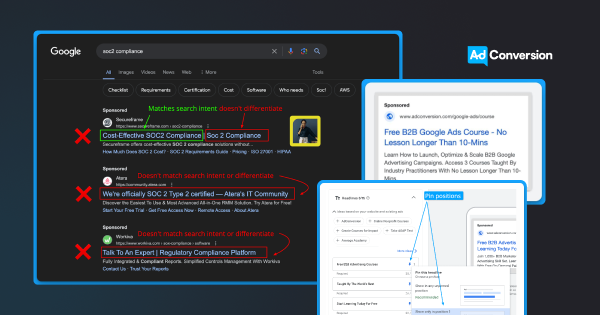
How to Write Effective Responsive Search Ads in 3 Simple Steps
Google Ads responsive search ads (RSA) don’t leave a ton of room available.
With 30 character headlines, and 90 character descriptions.
It’s tough to write persuasive and effective copy.
In this article you’ll learn a simple 3-step framework to write responsive search ads.
Let’s dive into it 👇
TABLE OF CONTENTS:
- The 3-Part RSA Writing Framework
- The Anatomy of a Responsive Search Ad
- Should you pin headlines and descriptions in Google Ads?
- Advanced copy tips for writing Responsive Search Ads
The 3-Part Google Ads RSA Writing Framework
Here's a simple 3-part framework for writing Google Ads copy:
- The goal of headline 1 = match intent
- The goal of headline 2 = differentiate between other results
- The goal of headline 3 = provide a clear CTA
Keyword: b2b google ads course
- H1: Free B2B Google Ads Course (matches intent)
- H2: No Lesson Longer Than 10-Mins (differentiates)
- H3: Join 1,000+ B2B Marketers (clear CTA)
Here's what it looks like in practice (image below):
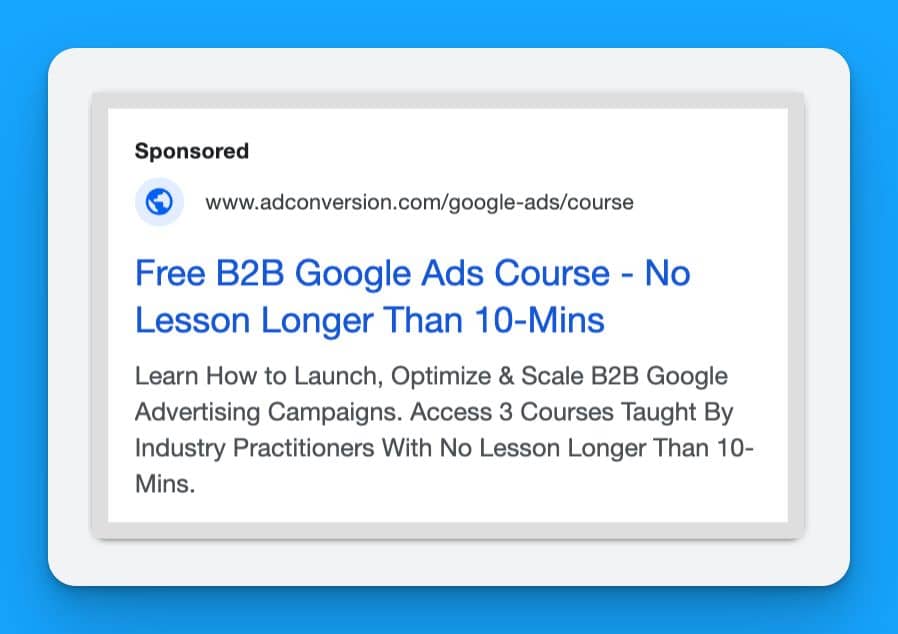
When writing, always assume the H3 isn't visible, and if only the H1 was displayed would they get it?
(Google is always testing different display variations)
From here you would write different variations per position.
With ensuring legibility between headline combinations.
Simple but effective ✌️let’s dive into each headline further.
The goal of headline 1 = match intent
You’ve got a fraction of a second for a prospect searching on Google to understand if your ad is relevant to their search term.
Don’t mess this up by being vague, asking rhetorical questions, or wasting valuable characters.

When it comes to Google Ads the headline 1 position would be eighty cents out of your dollar.
Maximize your headline 1 by adding the primary keyword in your copy to match intent.
This is such a simple thing to do, and equally not to.
The goal of headline 2 = differentiate between other results
Now that you’ve caught the searchers attention by matching intent it’s time to stand out.
Here’s a real example of what NOT to do from ads that appeared searching SOC2 compliance:
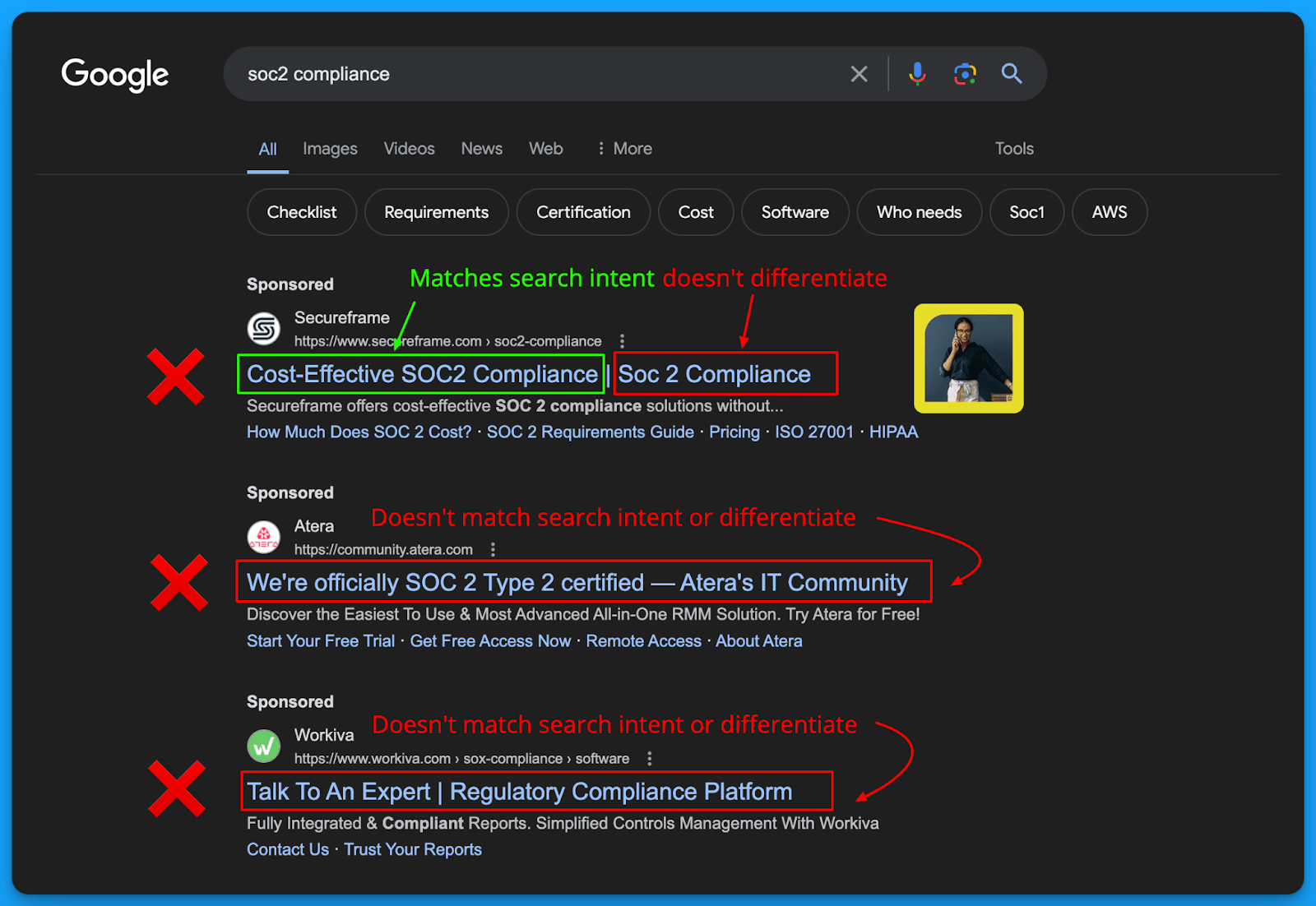
The sequence of which you write your headlines matter.
This is why I recommend following the 3-part framework as shown.
Use the headline 2 position to write a core benefit or outcome for differentiation.
The goal of headline 3 = provide a clear CTA
Finally in the third headline it’s time to provide a clear call to action.
This can be as simple as:
- Request a Demo
- See For Yourself
- Learn More Today!
When writing your H3 just assume it won’t be visible most of the time as Google is always experimenting with how they display headlines.
The Anatomy of a Responsive Search Ad
Now that you understand how to approach writing RSA copy.
Let’s discuss how responsive search ads actually function.
Character counts for Responsive Search Ads
- You can write up to 15 headlines, and 4 descriptions.
- 30 characters available per headline
- 90 characters available per description
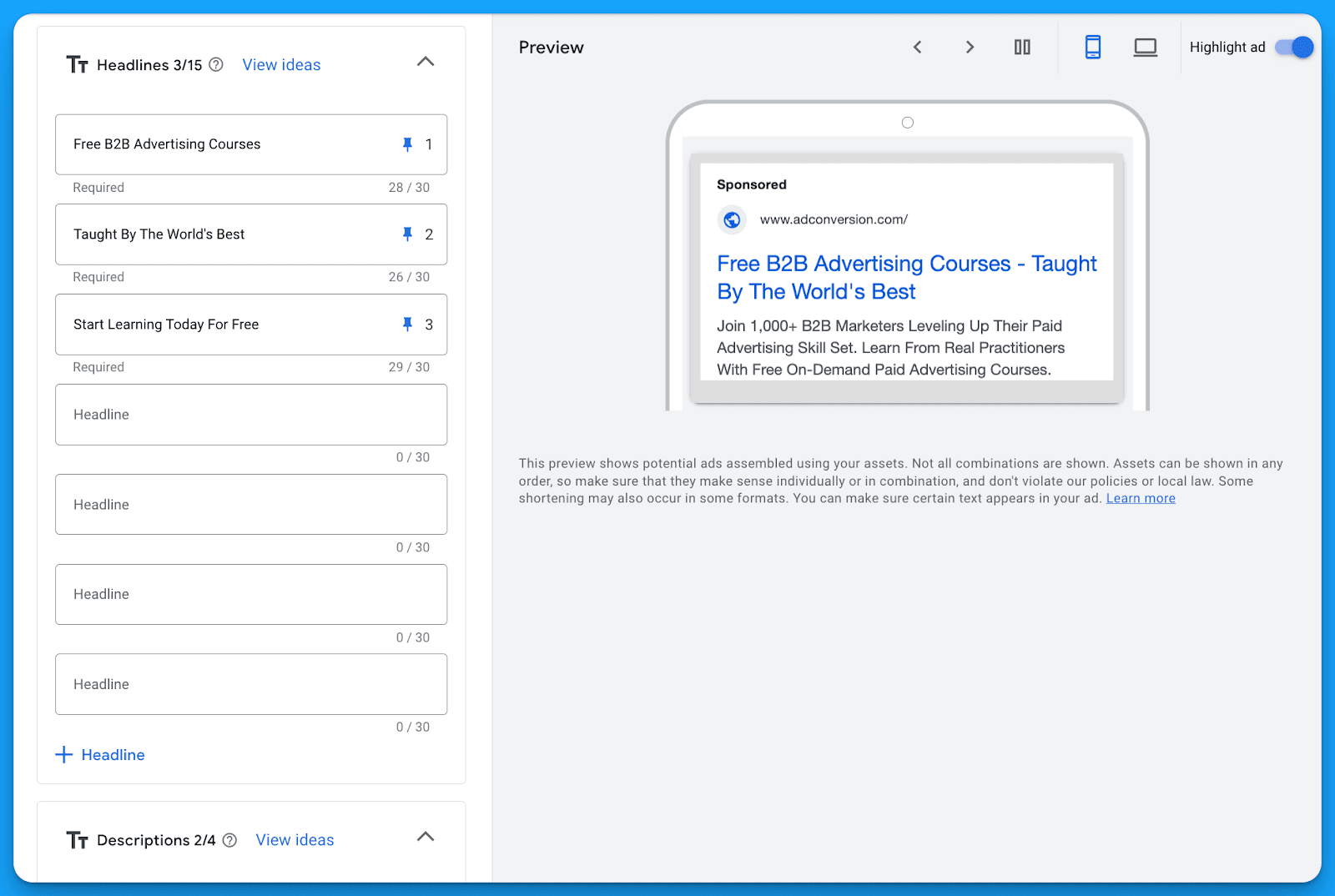
How Responsive Search Ads work
The idea behind responsive ads is Google will take your 15 headlines and 4 descriptions and automatically combine them to find the optimal variations based on machine learning.
The promise is you can leverage Google’s AI to do the heavy lifting as it will take into account a multitude of factors including keywords, search terms, devices, audience demographics and more.
Google also tries to guide advertisers on how well their doing when writing responsive search ads with their Ad Strength metric 💩(which we’ll cover in detail shortly).
With each headline and description you have the opportunity to pin positions.
This is where you’re forcing Google to only serve those variations within that specific placement.
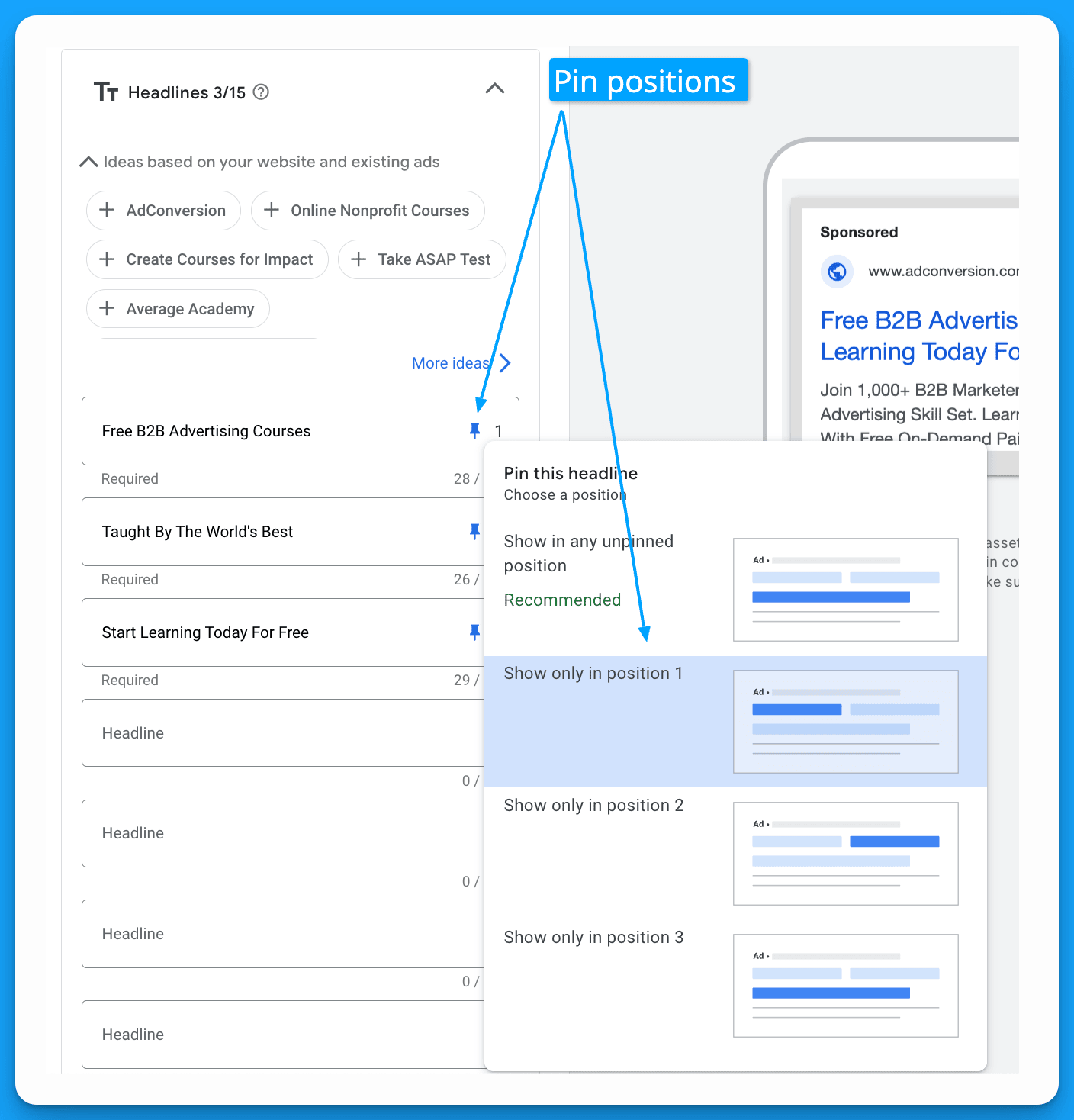
Should you pin headlines and descriptions in Google Ads?
The answer here is an unequivocal YES, because if your ads aren’t legible they won’t be clicked.
In a perfect world Google will automatically combine your headline and descriptions perfectly based on performance AND legibility but in reality it doesn’t happen.
Instead you end up with a bunch of variations like this:



I personally would LOVE ♥ ️ if Google’s AI can mix and match ads perfectly for performance and legibility but unfortunately the tech still isn’t there.
So in order to prevent this from happening I recommend strategic pinning.
How to pin Google Ads headlines strategically
In order to get the benefits of both Google’s AI to mix and match top performing headline/description combinations AND legibility you’ll need to pin strategically.
Here’s what it looks like in practice:
- Write 2-3 variations of Headline 1 and pin to position 1
- Write 2-3 variations of Headline 2 and pin to position 2
- Write 2-3 variations of Headline 3 and pin to position 3
- Write 2 variations of Description 1 and pin to position 1
- Write 2 variations of Description 2 and pin to position 2
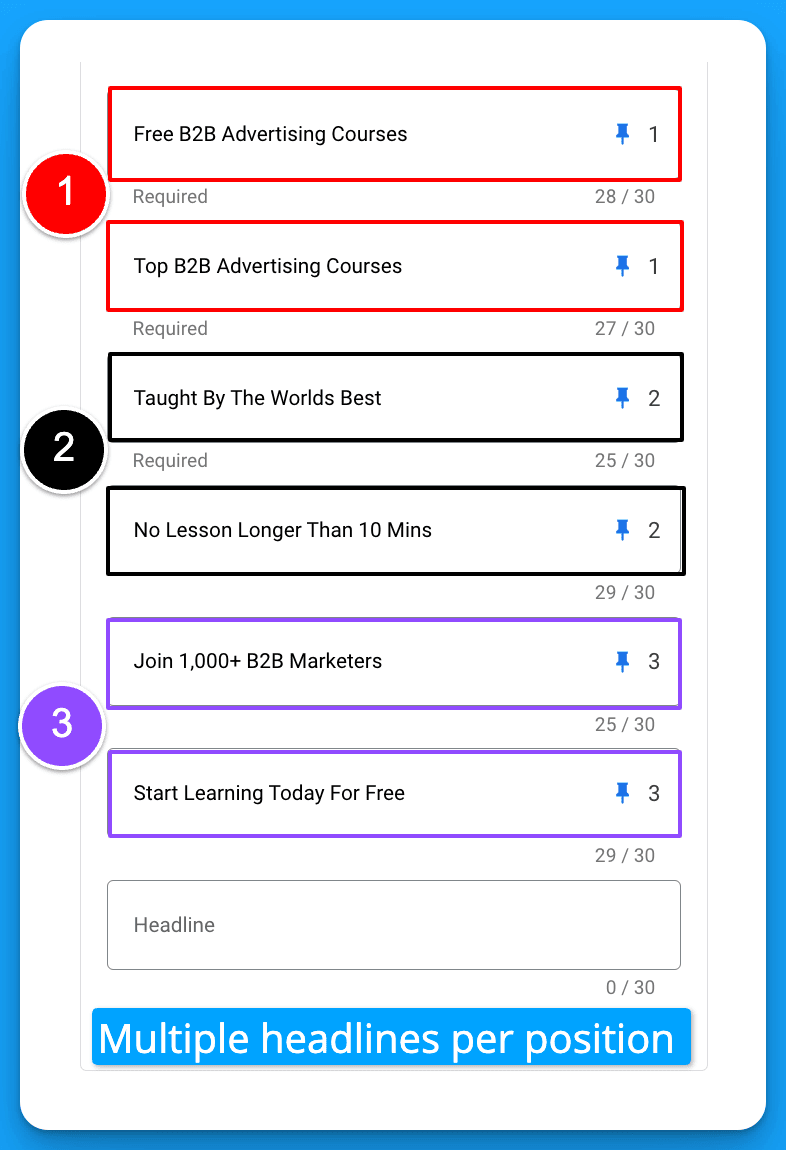
This will give you the benefit of testing multiple variations per position but safely as you can control which possible combinations are matched for legibility.
What is Ad strength and does it matter?
Ad strength is a score created by Google to help advertisers optimize their ad performance ranging from Incomplete → Poor → Average → Good → Excellent.

Ad strength misconceptions to be aware of
- Ad strength has ZERO bearing on actual performance, it's just a predictor of it.
- Having a poor ad strength doesn’t mean your ad won’t actually perform well.
- Having a poor ad strength doesn’t mean your ads won’t receive impressions.
What determines if your ad appears is your Ad Rank.

Pin strategically with 2-3 variations of headlines and you’ll be ok, it’s also what Google suggests if you decide to pin.

Advanced copy tips for writing Responsive Search Ads
Now that you know how to write effective responsive search ads let’s wrap with some advanced tips you can implement to make your ads perform even better.
Implement Dynamic Keyword Insertion (DKI)
Dynamic Keyword Insertion allows you to change your ad copy in real time based on the keywords that are triggering your ads in order to create more relevant experiences.
Currently there are 3 types of DKI available:
- Keyword Insertion = insert the keyword that triggers your ad
- Countdown = insert a timer that counts down to an event
- Location insertion = insert the location that triggers your ad

Test variations of your RSAs using relevant DKI parameters vs not to see if it impacts performance.
Leverage Business Name, Logo, and Image Ad Extensions
Now that Google allows you to highlight your business name and logo in your RSA, don't waste the characters anymore referencing your brand in your ad copy.
Save those valuable characters as you’re already getting brand awareness and instead maximize each character according to the 3-Part Google Ads RSA writing framework.
Ad extensions should always be used as a best practice but when it comes to writing effective Google Ads copy don’t forget to utilize your extensions to provide more information.
Hope you found this article helpful, best of luck on your next set of ads!
From Clicks to Conversions: Master Google Ads for B2B 🔥
If you want to become a Google Ads pro, check out our free B2B Google Ads courses, where you'll learn how to launch, optimize, and scale your campaigns to drive pipeline and revenue.

Here's what you'll learn in each course:
⚙️ B2B Google Ads 101 - How to Launch Dangerously Effective Campaigns for Beginners
- The Googleverse: The Game You're Playing & How To Win
- Measurement: How to Make Sure You're Profitable
- Targeting: How to Show Up For the Right Searcher
- Planning: Putting It All Together
🎯 Google Ads 102 - How to Clicks Into Profit
- Visibility: How To Find the Hole Sucking Profits
- Workflows: How to Optimize On a Daily, Weekly, Monthly & Quarterly Basis
- Experimentation: How to Test & Automate Profitability
- Troubleshooting: How To Solve Inevitable Problems
🚀 Google Ads 103 - How to Scale Google Ads For Advanced Advertisers
- Methodology: How to Vertically Scale Google Ads From A-Z
- Campaigns: Scaling Horizontally Through Campaign Themes
- Channels: Scaling Outside of Paid Search
Click Here to Join 1,000+ B2B Marketers Today and start leveling up your advertising skill set.
Takes < 90 seconds to sign up (seriously we timed it 😂)
People Also Ask
How can I effectively measure the performance of my RSAs?
Utilize Google’s Ad Strength indicator to assess the quality and relevance of your ads. Additionally, monitor key performance indicators (KPIs) such as click-through rates (CTR), conversion rates, and cost per conversion to evaluate ad effectiveness. 
What are the best practices for creating compelling headlines and descriptions in RSAs?
Develop diverse and unique headlines that highlight different aspects of your product or service. Incorporate relevant keywords in at least two headlines to improve ad relevance. Ensure that each headline and description provides distinct value to avoid redundancy.

Should I pin headlines and descriptions in my RSAs?
Strategically pinning headlines and descriptions can ensure legibility and relevance. Pinning specific headlines to designated positions helps maintain coherent messaging, especially when certain combinations may not make sense together. However, over-pinning can limit Google’s ability to optimize combinations. 
What role does Google’s machine learning play in the effectiveness of RSAs?
Google’s machine learning algorithms automatically test various combinations of headlines and descriptions to determine the most effective ad for each search query. By providing a diverse set of assets, you enable the system to optimize ad delivery and improve performance over time. 
How can I ensure my RSAs align with my overall marketing strategy?
Ensure that the messaging in your RSAs is consistent with your brand voice and marketing objectives. Regularly review ad performance data to make informed adjustments, and coordinate with other marketing channels to maintain a unified approach.

How to Create a Winning Google Ads Budget Strategy for B2B SaaS
Thinking about investing in Google Ads for your SaaS but not sure how much it will cost?
In this article I’ll break down how to create a winning budget strategy step by step.
You’ll walk away knowing how much you’ll need to invest on a daily, monthly, and quarterly basis.
And most importantly if Google Ads makes sense for your business.
Let’s dive into it 👇
TABLE OF CONTENTS:
- How much budget is required for a starting Google Ads budget?
- How to forecast a daily, monthly, and quarterly Google Ads budget
- How to allocate Google Ads budget by campaign strategy
- Frequently asked Google Ads budget questions
How much is required for a starting Google Ads budget?
This is the first question that usually comes to mind when considering Google Ads.
Which will then be met with a variation of questions such as:
- Is $10/day enough for Google Ads?
- Is $100/day enough for Google Ads?
- Is $1,000/day enough for Google Ads?
And so on, and so on…
When the reality is it’s all circumstantial based on the keywords you’re looking to target.
Equally important to how much is required is how many people are searching?
You could have a keyword that costs $0.01 per click but if only 5 people search is it really worth it?
So in order to answer this question you have to perform keyword research with the Keyword Planner.
Navigate to Tools > Planning > Keyword Planner within your Google Ads account to access it.
It doesn’t cost anything to open a free Google Ads account so anyone can access this tool.
Within the Google Ads Keyword Planner enter your dream keyword you want to research.
For example, I’ll use “google ads courses” as an example:

After researching I can see the following keyword costs and monthly volume estimates:
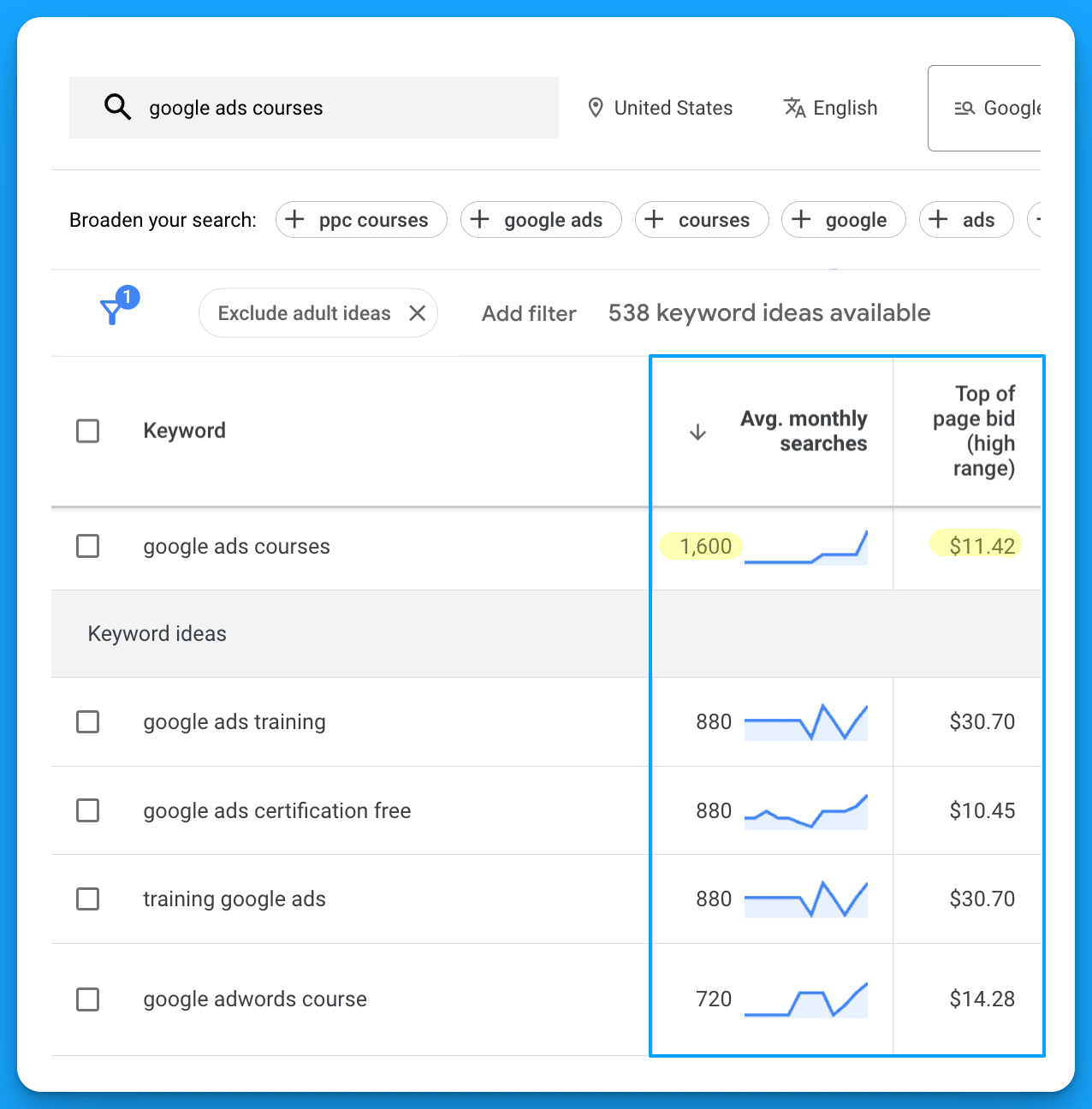
I recommend always using the top of page bid (high range) as your estimate.
I’ve never seen these estimates be 100% accurate and you’ll never know your real CPC until launch.
To account for this margin of error I recommend adding +20% on top of your top of page estimate.
This means in our google ads courses example:
- It would potentially cost me $13.7 per click ($11.42 +20%)
- I can receive up to 1,600 clicks per month in the USA.
Based on these two data points we can assume it’s possible to spend up to $21,920 per month on this keyword ($13.7 * 1,600).
Outside of the return on investment, don’t forget about return on effort.
If your dream keywords have very limited search volume (ex: < 100/month) it might not be worthwhile.
How to forecast a daily, monthly, and quarterly Google Ads budget
Once you know your estimated cost per click you’re ready to put together a forecast.
We’ve created a free Google Ads Budget Calculator tool that you can use to easily plan your daily, monthly, and quarterly budget.
You’re going to need the following information for the forecast:
- Your average cost per click (from the Keyword Planner or real data)
- Your quarterly sales goal
- Your average win rate
- Your average revenue per sale
With all this information at hand you’ll plug these different values into the calculator.
Based on your landing page conversion rates you can model a worst, moderate, and best case.

From here you can see how much it will cost to acquire a customer and the budget required to hit your sales volume target.
I highly recommend paying attention to the number of clicks required per lead, this will help frame expectations on how much traffic you’ll need and if your search volume is sufficient.
As you’ll see, your landing page effectiveness is essential at reducing costs 💥
With this forecast at hand you’ll know exactly how much to invest.
How to allocate Google Ads budget by campaign strategy
You should be clear on how much you’ll need to invest in your Google Ads campaigns.
Now the next step is to figure out how you’re going to allocate your budget.
In my experience managing Google Ads campaigns for B2B SaaS companies, there are five proven campaign themes to invest in; NonBrand, Brand, Competitive, RLSA, and Content.
Here’s my recommendation on budget allocation by each if you want to maximize volume.
Use all of these as starting points and modify the amounts based on your data/nuances.
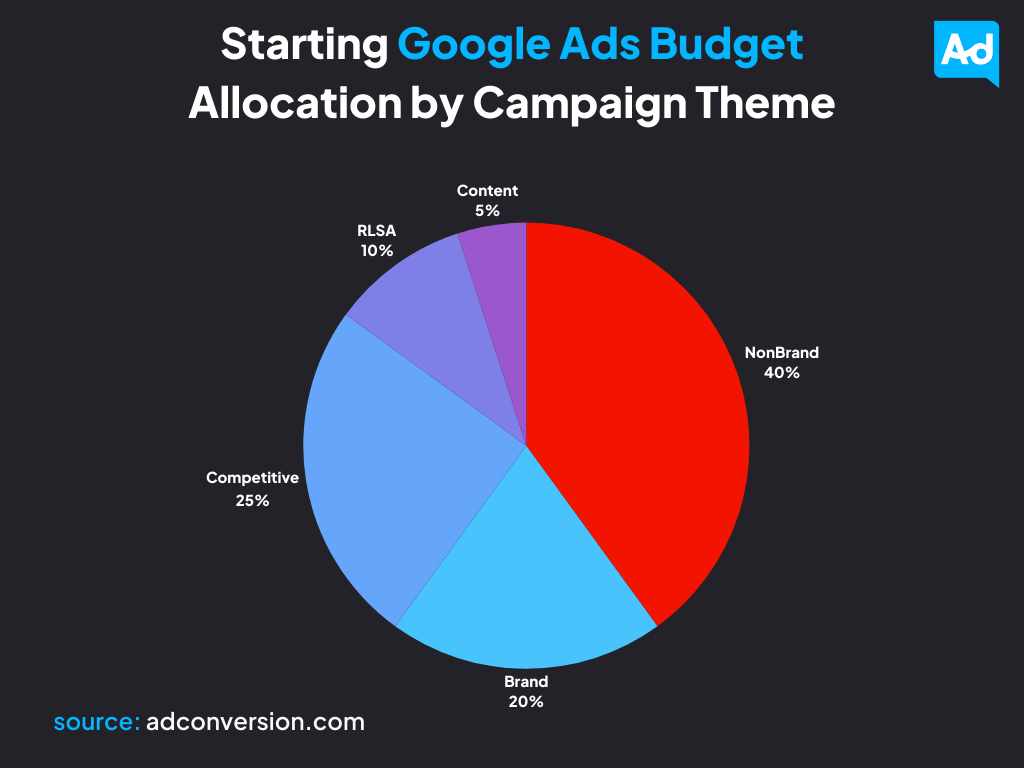
NonBrand = 40% of total budget
NonBrand campaigns are where you’re bidding on high-intent keywords that don’t include your brand, for example google ads courses would be non brand for us at AdConversion.
Think about your keywords you’d like to cover that problem aware prospects would search for.
NonBrand keywords typically contain high-intent modifiers such as:
- Software
- Platform
- Tool
- Technology
- Solution
If you have enough search volume on non brand keywords there’s no easier way to drive conversions than showing up for people looking for solutions to their problems.
Brand = 20% of total budget
Brand campaigns are commonly referred to as “defense” campaigns where you’re bidding on your own brand name to outrank competitors bidding on yours.
You can make the case that people searching your branded terms would convert anyways and it’s not worth the investment.
This is why I recommend no more than 20% of the total budget on this campaign initially.
I’ve seen exceptions here with some of our clients where they saw net new revenue decline significantly from pausing their branded campaigns.
Let your data guide your allocation.
Competitive = 25% of total budget
Competitive campaigns are the opposite of brand where you’re bidding on competitors' names to appear for their existing customers and prospects.
These campaigns can be really hit or miss depending on your execution.
Make sure you’re doing it in a classy way and have dedicated comparison pages.
This theme can be really powerful at driving qualified traffic as these searchers are solution aware.
RLSA = 10% of total budget
RLSA stands for remarketing list for search ads.
This just means search remarketing, anyone that searches your keywords AND is part of an audience.
For example, anyone that has been to your site in the past 90 days and is searching your keywords.
RLSA campaigns can be really powerful when you have enough site traffic and are dealing in competitive niches.
Depending on your available remarketing audience sizes you can decide if this makes sense initially.
Given the limitation of size we typically only allocate 10% here to begin.
Content = 5% of total budget
Content campaigns are great for supporting SEO efforts.
If you have certain keywords you’re struggling to rank for, content campaigns are worth investigating.
This is where you’re going to bid on longtail content related keywords that typically have much lower cost per click prices and drive that traffic to a blog or relevant content piece.
Depending on your content strategy I’d give this some consideration.
Hope you found this article helpful! and now know how to create a winning Google Ads budget strategy.
Frequently asked Google Ads budget questions
Does Google Ads work on a small budget?
Yes, and no. Small is relative to your average cost per click prices.
I’d recommend being able to afford at least 100 clicks per month.
Does Google Ads work for B2B SaaS?
Absolutely, intent is what makes Google Ads so powerful.
The biggest challenge for B2B SaaS is scale.
What is a good Google Ads budget?
A Google Ads budget is one where you can support your business objectives.
Using the following information you can create a forecast to understand what is good:
- Your average cost per click
- Your quarterly sales goal
- Your average win rate
- Your average revenue per sale
From Clicks to Conversions: Master Google Ads for B2B 🔥
If you want to become a Google Ads pro, check out our free B2B Google Ads courses, where you'll learn how to launch, optimize, and scale your campaigns to drive pipeline and revenue.

Here's what you'll learn in each course:
⚙️ B2B Google Ads 101 - How to Launch Dangerously Effective Campaigns for Beginners
- The Googleverse: The Game You're Playing & How To Win
- Measurement: How to Make Sure You're Profitable
- Targeting: How to Show Up For the Right Searcher
- Planning: Putting It All Together
🎯 Google Ads 102 - How to Clicks Into Profit
- Visibility: How To Find the Hole Sucking Profits
- Workflows: How to Optimize On a Daily, Weekly, Monthly & Quarterly Basis
- Experimentation: How to Test & Automate Profitability
- Troubleshooting: How To Solve Inevitable Problems
🚀 Google Ads 103 - How to Scale Google Ads For Advanced Advertisers
- Methodology: How to Vertically Scale Google Ads From A-Z
- Campaigns: Scaling Horizontally Through Campaign Themes
- Channels: Scaling Outside of Paid Search
Click Here to Join 1,000+ B2B Marketers Today and start leveling up your advertising skill set.
Takes < 90 seconds to sign up (seriously we timed it 😂)

14 Powerful LinkedIn Thought Leader Ad Strategies Worth Testing
Everyone knows that B2B buying has changed.
People trust people more than they trust companies, making thought leadership ads more important than ever before.
If you’re looking to use thought leader ads in your LinkedIn ad strategy but aren’t sure how to get started, this article is for you.
Here are 14 thought leader ad plays and examples you can test.
Let’s jump into it! 👇
TABLE OF CONTENTS:
- Play #1: Announce new product features, integrations, and partnerships
- Play #2: Highlight the main problem your product solves + the solution it provides
- Play #3: Highlight a case study featuring your own company
- Play #4: Highlight a case study featuring one of your customers
- Play #5: Generate buzz before attending an in-person event
- Play #6: Stay top of mind after an event
- Play #7: Promote your own event
- Play #8: Promote an upcoming webinar
- Play #9: Promote your newsletter
- Play #10: Celebrate Customer Wins
- Play #11: Demo different use cases of your product
- Play #12: Share long-form content with insights that your ICP would be interested in
- Play #13: Provide practical advice based on insights from your platform
- Play #14: Leverage social proof from existing customers
Play #1: Announce new product features, integrations, and partnerships
🔑 to success: Trust your audience. Target the experts and speak to them like they’re experts. Show them all the cool things they’ll be able to achieve with your product.
Example 1: Dreamdata

Example 2: Gong

Example 3: UserGems

Example 4: Dreamdata

Play #2: Highlight the main problem your product solves + the solution it provides
🔑 to success: After prospects read your content, they should be able to clearly articulate the problem your product solves + the solution it provides. If they can’t, you need to simplify your messaging.
Example 1: Apollo

Play #3: Highlight a case study featuring your own company
🔑 to success: Show how your team is using YOUR tool to reach YOUR goals – your company can serve as its own case study.
Example 1: UserGems

Example 2: Apollo

Example 3: Sendoso

Example 4: Salesloft

Play #4: Highlight a case study featuring one of your customers
🔑 to success: Clearly articulate how you’ve been helping an existing customer achieve their goals.
Example 1: Lavender

Example 2: Loxo

Play #5: Generate buzz before attending an in-person event
🔑 to success: Use an ABM list of attendees or ABM list of companies + key job functions to make sure you’re getting in front of the right people.
Example 1: HockeyStack

Play #6: Stay top of mind after an event
🔑 to success: Have an attendee post a recap after an event so that your brand is staying top of mind in the following weeks. The idea isn’t to push your product, but to keep raising awareness within key accounts.
Example 1: Sendoso

Play #7: Promote your own event
🔑 to success: Have your event speakers announce their participation on their personal pages and boost the posts to increase overall reach. This is a win for the speakers and for your company – speakers will feel supported and your event will get more registrations.
Example 1: Gleanin

Example 2: Gleanin

Play #8: Promote an upcoming webinar
🔑 to success: Clearly highlight the value of the webinar for your audience – what will they learn by attending? Make sure to tag the speakers to generate more interest.
Example 1: Sendoso

Example 2: Copy ai

Example 3: DoWhatWorks

Play #9: Promote your newsletter
🔑 to success: Keep it simple & highlight what people will get out of subscribing.
Example 1: Motion
.png)
Play #10: Celebrate customer wins
🔑 to success: Highlight customers when they win an award or achieve something big. This strategy provides social proof to help with prospecting efforts, but it’s also a great retention play, as it makes existing clients feel supported.
Example 1: Sendoso

Example 2: Lavender

Play #11: Demo different use cases of your product
🔑 to success: Have a senior leader – from your own company or one of your customers – educate prospects on how they can use your product to achieve their business goals.
Example 1: Dreamdata

Example 2: Clay

Example 3: Clay

Play #12: Share long-form content with insights that your ICP would be interested in
🔑 to success: Don’t tell everyone how great your product is – instead, show them the insights they could have access to if they used it. Also, make the content industry-specific. For example, content about conversion impact or email subject lines in B2B SaaS will be much more powerful than content about conversions or email in general.
Example 1: HockeyStack

Play #13: Provide practical advice based on insights from your platform
🔑 to success: Don’t provide generic advice that people have heard many times. Instead, give advice that your ICP may find surprising, and always back it up with data from your platform. This strategy is powerful because potential buyers will be grateful for the thought leader’s recommendations AND they’ll also relate the thought leader’s content to your organization (and hopefully be interested in learning more).
Example 1: Lavender

Play #14: Leverage social proof from existing customers
🔑 to success: Promote content from respected customers within your target industry highlighting the use cases and overall impact of your product.
Example 1: UserGems

Example 2: Clay

Putting LinkedIn Thought Leader ads into action
If you’re excited about thought leadership ads and want to start running them right away, here’s what I would recommend:
1. Find a few people at your organization that would be great thought leaders. They don’t need to be influencers with 50K followers – they simply need to have a deep understanding of your product and your ICP (bonus if they also enjoy writing).
2. Once you’ve selected your thought leaders, choose the top 3 strategies from this playbook that you’d like to begin with. I don’t recommend starting with all 14 strategies at once, since that could get pretty overwhelming.
3. Have your thought leaders post a few times per month and boost their content to your ICP.
That’s all you need to get started.
P.S.
If you’re starting out with thought leadership ads, I recommend using the engagement objective to build your retargeting audiences in a cost-effective way.
And if you want a complete masterclass on LinkedIn ads objectives, ad types, and bidding strategies, I highly recommend checking out this article by Ali Yildirim.
Master B2B LinkedIn Ads with these 3 Free Courses:
If you want to become a LinkedIn Ads pro, check out our free B2B LinkedIn Ads courses, where you'll learn how to launch, optimize, and scale your campaigns to drive pipeline and revenue.

Here's what you'll learn in each course:
⚙️ B2B LinkedIn Ads 101 - The Ultimate Crash Course for New LinkedIn Advertisers
- Foundations For LinkedIn Ads Success
- Measurement: Tracking & Key Principles
- Targeting: Reaching Your Dream Buyers
- Ads: Mastering The 9 Ad Formats
🎯 B2B LinkedIn Ads 102 - The Blueprint for LinkedIn Ads Optimization
- Monitoring: How To Spot Performance Trends
- Auditing: How To Find The Darlings You Need To Kill
- Reporting: How To Transform Data Into Insights
- Optimization: How To Make Your LinkedIn Ads Profitable
🚀 B2B LinkedIn Ads 103 - Advanced Scaling Strategies From $25M In Ad Spend
- Concepts of Scaling
- Divide and Conquer
- Learnings From $25M+ In LinkedIn Ad Spend
Click Here to Join 1,000+ B2B Marketers Today and start leveling up your advertising skill set.
Takes < 90 seconds to sign up (seriously we timed it 😂)
People Also Ask
What are LinkedIn Thought Leader Ads, and how do they differ from standard LinkedIn ads?
LinkedIn Thought Leader Ads allow companies to sponsor posts from individual profiles, such as company leaders or industry experts, rather than from the company page. This approach leverages personal connections and trust, often leading to higher engagement compared to standard company-sponsored ads. 
How can I select the right individuals for Thought Leader Ads within my organization?
Choose individuals who have a deep understanding of your product and ideal customer profile (ICP), and who are comfortable creating engaging content. They don’t need to be influencers with large followings; authenticity and expertise are key. 
What types of content work best for LinkedIn Thought Leader Ads?
Effective content includes announcing new product features, sharing case studies, promoting events or webinars, and providing practical advice based on insights from your platform. The goal is to offer valuable information that resonates with your target audience. 
How can I measure the success of my LinkedIn Thought Leader Ads?
Monitor metrics such as impressions, engagement rates, click-through rates (CTR), and conversions. Additionally, assess qualitative feedback like comments and shares to gauge how the content resonates with your audience. 
What are some best practices for creating effective LinkedIn Thought Leader Ads?
Ensure the content is authentic and aligns with the thought leader’s voice. Optimize the individual’s LinkedIn profile as it serves as a landing page for interested viewers. Use high-quality visuals, clear messaging, and include a call-to-action to guide the audience’s next steps.

10 Effective Account-Based Marketing Tactics For Modern B2B Marketers
Do you need to find out if ABM is the right approach for you & how you can get the most out of your efforts?
I had the pleasure of interviewing Brandon Alisoglu who’s achieved a 300% increase in demo bookings for B2B companies while maintaining a 50% SQL rate from ABM campaigns.
Here’s Brandon’s top 10 tips & tactics to maximize return on effort (ROE) for your ABM ads.
(In no particular order, they all matter)
TABLE OF CONTENTS
- Tip #1 - Assessing the Suitability of ABM for Your Business
- Tip #2 - Embracing the Long Game in Account-Based Marketing (ABM)
- Tip #3 - Create a Dossier of Information
- Tip #4 - Breaking Content to Audience Segmentation
- Tip #5 - Focusing on Outcomes: The "So What?" Factor in ABM
- Tip #6 - Drilling Into Personas & Messaging
- Tip #7 - A/B Testing Value Propositions
- Tip #8 - Set Aside Time to Ideate
- Tip #9 - Streamlining the Process with Templates
- Tip #10 - Don’t Skip Google
- Conclusion
- Resources for mastering B2B advertising
Tip #1 - Assessing the Suitability of ABM for Your Business
When evaluating ABM for your business, consider the nature of your target accounts and the practicality of a personalized marketing approach.
ABM is particularly effective for targeting large organizations or "whales" where the potential return justifies the extensive effort and resources required for highly tailored campaigns.
Challenges with ABM in Smaller Companies
In smaller companies, the lack of numerous distinct roles and seniority levels may limit the effectiveness of ABM strategies that rely on granular targeting and personalized messaging.
If a company is too small to segment effectively based on these criteria, the impact of a tailored ABM approach may be diminished.
ABM often involves high-ticket offerings and significant investment in marketing resources.
If the target account does not have the financial capacity or the organizational complexity, the return on investment might not be worth it.
Strategic Considerations for ABM
Evaluate potential accounts not just by their immediate size but by their strategic importance and the potential lifetime value they offer.
Consider more generalized targeted advertising strategies for smaller accounts that do not justify a full ABM approach.
These can still be effective by focusing on industry-specific pain points and solutions but do not require the level of customization and operational complexity associated with traditional ABM.
Identifying the Annual Contract Value (ACV) Benchmark
An ACV of around $20,000 is generally seen as a threshold where ABM becomes viable.
This benchmark suggests that the deal size is significant enough to warrant the detailed and personalized marketing efforts required in ABM.
Another practical measure is whether the contract value requires CFO approval.
The involvement of a CFO generally indicates that the deal is substantial enough to require careful consideration and alignment with strategic financial goals.
Tip #2 - Embracing the Long Game in Account-Based Marketing (ABM)
Unlike traditional demand generation tactics that may prioritize immediate results, ABM focuses on building engagement through a more deliberate and personalized approach.
The idea here is to build a meaningful relationship with key accounts.
In the same way, you wouldn't ask for a hand in marriage on the first date, successful B2B marketers shouldn’t ask prospects to talk to sales unless they've had some interaction before.

The Importance of Educating and Engaging
The early stages of ABM should center around education and awareness.
Allow targeted accounts to familiarize themselves with your brand and value propositions.
This foundational phase is important for setting the stage for deeper engagement.
Jumping directly to aggressive sales tactics like pushing for demos with accounts that have minimal interaction with your brand, is less likely to yield positive results.
Instead, nurturing relationships over time fosters trust and increases the likelihood of conversion when the account is ready.
Balancing Immediate Needs with Long-Term Strategy
While the emphasis on the long game is important, we realize the need to meet short-term sales targets is a pressing reality for most B2B marketers.
In such cases, employing a robust account scoring system can help identify which accounts are most ready to engage based on their behaviors such as:
- Website visits (specially high-intent pages)
- Ad engagement
- Email interactions
- Webinar attendees
For accounts that show clear signs of being in-market or closer to the decision stage, tailor your approach to convert these opportunities.
This can involve more direct calls to action, such as personalized demo invitations and running incentivized offers.
If your company is product-led, this would be a good time to offer free trials.
Sample of free trial ad by Plauti:

Tip #3 - Create a Dossier of Information
Understanding your prospects' interests, pain points, and engagement history comprehensively is the key to crafting personalized and effective ABM strategies.
This information equips sales teams with the required data to personalize their outreach effectively and accelerate the sales process.
Building & Targeting Prospect
Compile data on prospect activities, including the specific ads they clicked, pages they visited, or any communications they have sent.
This dossier should act as a dynamic document that sales teams can use to personalize their approaches.
By understanding what content the prospect has engaged with, the sales team can address specific interests or pain points, making their pitches more relevant and compelling.
Marketers can also use this data to launch 1:1 campaigns featuring social proof and objection handling.
If the list of accounts is not large enough for a 1:1 approach, then gather the top 3-5 most common objections that resonate with the majority of the accounts.
You can reduce the overall cost by dynamically excluding any account that has contacted sales.
Implementation Tips for Effective ABM
- Identify in-market accounts by using advanced analytics and account scoring to determine which of your target accounts are actively engaging with your content.
Tools like HubSpot or Marketo can help streamline the process.
- Once these engaged accounts are listed, segment them for targeted campaigns that address their specific stages in the buyer’s journey.
This segmentation allows you to apply more aggressive sales tactics appropriately while continuing to nurture less-ready accounts with educational content.
- Distribute content that educates and engages at various stages of the customer journey.
This tactical approach ensures that when you invite accounts to a demo or free trial they are informed and more likely to be receptive.
Successful ABM is a blend of patience and strategic agility, tailored to meet both the immediate and long-term goals of your business.
Tip #4 - Breaking Content to Audience Segmentation
The purpose of this step is to develop and deliver content that addresses specific pain points and interests identified in your prospect dossiers.
Strategies for Deepening Prospect Engagement
As you gather more data on your prospects' behaviors, such as the ads they click or the pages they visit, use this information to guide them through a personalized buyer's journey.
This involves crafting content that speaks directly to their needs and leading them to web pages that provide further value and deepen their engagement with your brand.
Regularly update and refine your ads to keep them in line with your audience's changing interests and needs.
Creating a Content "Buffet"
Offer a Variety of Content Options.
Imagine setting up a buffet of content options tailored to different tastes and preferences within your target accounts.
By providing a range of topics and formats—from whitepapers and case studies to webinars and interactive tools—you allow prospects to self-select the content that most resonates with them.
Use the insights from observed interactions to refine your understanding of what each prospect cares about.
This personalized approach not only enhances the relevance of your outreach but also increases the likelihood of a prospect's deeper engagement with your content.

Integrating Technology for Efficiency
While managing this level of personalized engagement can become complex, employing an ABM platform can streamline the process.
These platforms can help organize and automate content delivery based on user behavior, keeping track of interactions across different channels to maintain a cohesive and personalized marketing approach.
Pro tip:
Before fully investing in an expensive ABM tech stack, validate your strategy with simpler tools or minimal setups to prove its effectiveness.
A simple way is to use LinkedIn's demographic reporting to see which companies have been exposed to impressions, and which ones are actually engaging.
You can take it a step further and leverage a third-party data connector like data slayer to pull the demographic data from LinkedIn through API.
Tip #5 - Focusing on Outcomes: The "So What?" Factor in ABM
A critical aspect of effective ABM is ensuring that every piece of data, every content interaction, and every campaign has a clear and compelling answer to the question: "So what?"
Every action should educate, nurture, or capture leads, to bring you closer to revenue.

The Importance of Outcome-Based Messaging
In ABM, it's not enough to highlight the features of your product or the hours it can save a potential client’s team.
The key is to articulate what these benefits mean in the context of the customer’s specific business challenges and goals.
When discussing a product feature, such as "saves your engineering team 20 hours a week," it's essential to connect this benefit to tangible business outcomes.
For example, what does saving 20 hours a week mean for the company?
Could it lead to faster project completions, cost savings, or better resource allocation?
These outcomes are what will truly capture the interest of decision-makers.
By consistently focusing on the "so what?" of your actions and messaging, you can lift your ABM efforts from functional to transformational.
Pro-tip:
Establish Leading Indicators to Measure ABM Progress:
By establishing clear leading indicators across your marketing funnel, you can quantify progress and tie every action back to tangible business outcomes.
From initial awareness through engagement to conversion, each stage can be monitored and analyzed to ensure marketing efforts move potential clients closer to a sale.
These indicators provide a roadmap that justifies the investment by showing how specific activities contribute to moving accounts through the sales pipeline.
If you want to learn more about creating leading and lagging indicators along with actionable free templates check out the AdConversion Paid Media Program course; Module 2, lesson 1.

Tip #6 - Drilling Into Personas & Messaging
Within any given company, different levels of management and seniority have distinct priorities and challenges.
For example, C-suite executives might focus on strategic growth and scalability, directors on operational efficiency, and managers on tactical execution.
Tailoring your messaging to address these specific concerns can dramatically increase the relevance and impact of your communications.
Beyond role-based customization, consider the particular needs and pain points of the industry or vertical your target accounts might operate within.
Strategies for Effective A/B Testing
Implement continuous A/B testing across your campaigns to determine which messages resonate best with each persona.
Segment your target audience by role and seniority, and tailor your messages accordingly.
For example, test different value propositions with managers versus C-suite executives to determine which messages drive more engagement or conversions from each group.
Understand that the preferences and behaviors of your audience can evolve, and your ABM strategy should be agile enough to adapt to these changes.
Tip #7 - A/B Testing Value Propositions
By testing two to three variations of each message, you can discover appeals and incentives that resonate with distinct groups within the same role and seniority level.
In cases where the target company might not be large enough to segment by job titles or seniority due to LinkedIn’s filtering limitations, marketers need to think creatively about how to approach personalization and segmentation.
Alternative Segmentation Strategies:
- Use Broad Segments:
Instead of job titles, consider using job function and seniority or even adding member skills into the mix.
- Focus on Common Pain Points:
Leverage the common challenges or objectives identified in smaller organizations.
For example, if most employees are likely involved in decision-making due to the company's size, tailor messages that address broad business benefits that resonate across multiple roles.
As discussed earlier, knowing the top objections by vertical can guide the creation of content and ads that preemptively address concerns.
This is particularly useful when precise job title segmentation is not feasible.
Tip #8 - Set Aside Time to Ideate
In the fast-paced environment of account-based marketing, it's imperative to carve out dedicated time for creative thinking and experimentation.
By blocking out time on your calendar, preferably during quieter hours like Friday afternoons, you ensure that you have the space to think deeply and creatively about your ABM strategies.
Regular ideation sessions allow you to review current insights and performance data, enabling you to develop new approaches and refine existing ones.

Pro tip:
Leverage Experimentation and Documentation:
Incorporate a structured approach to experimentation.
Try out new ideas on a small scale to assess their effectiveness before rolling them out broadly.
Keep detailed records of your experiments, including:
- Hypotheses
- Execution details
- Outcomes.
This documentation enables you to capitalize on effective strategies and avoid past mistakes.
Tip #9 - Streamlining the Process with Templates
Keeping detailed and organized documentation of ABM activities, such as experiments, outcomes, and insights will save you lots of time & effort in the long run.
It can be as simple as using Google Docs with structured headings and a table of contents.
Consistent documentation helps in creating a reliable record that can be referenced in reports and strategy meetings.
Leveraging Design Templates
Design templates allow marketers to quickly generate new versions of ads or content without starting from scratch each time.
By standardizing the design elements, teams can focus on tweaking the messaging and content to better align with the target audience’s evolving preferences.
Using templates also ensures that all materials produced are aligned with the brand’s visual identity and messaging guidelines.
Effective Use of Templates and Documentation
Develop a range of design templates for different types of content and ads.
This library should include templates for social media posts, email campaigns, and other marketing materials that are frequently used in ABM campaigns.
Regularly update the documents with the latest results from A/B tests, data analysis insights, and feedback from sales and marketing teams to maintain accuracy and relevance.
Confirm that all team members are trained on how to use the chosen documentation and templates effectively.
With the design templates in place, focus on iterating on the creatives frequently.
Especially in smaller audience segments where ad fatigue can set in quickly.
Tip #10 - Don’t Skip Google
While (ABM) often focuses on direct and personalized communication channels like LinkedIn, incorporating Google Ads into your Demand Gen strategy can heavily reduce the overall cost per acquisition (CPA).
The Strategic Use of Google Ads
Google Ads allows you to address specific queries and pain points that your prospects are actively searching for.
By focusing on these queries, you can position your company as a solution provider right at the moment of need, effectively answering potential customers’ questions through targeted ads.
Often, niche or less competitive keywords related to specific industry questions or problems can be much cheaper than more general, high-intent keywords.
For example, targeting a specific industry debate or a lesser-known feature comparison can capture relevant traffic at a significantly lower cost.
This, not only increases brand awareness but also positions your company as an authoritative and helpful resource.
Creating content that addresses these queries and promoting it through Google Ads can drive highly targeted traffic to your website, increasing the chances of conversion.
Practical Tips for Implementing Google Ads
- Work with your sales and customer service teams to pinpoint the questions and topics that commonly arise during the sales process.
- Use these insights to guide your keyword and content strategy for Google Ads.
Develop content that answers these questions comprehensively.
This could be in the form of blog posts, FAQs, or educational articles.
- Use the identified keywords to set up Google Ads campaigns.
Start with a lower budget to test the effectiveness of your keywords and ads.
Monitor the performance and adjust your strategy based on the results.

Conclusion:
In this article, we discussed the significance of Account-Based Marketing (ABM) strategies through 10 practical tips and tactics to get the most out of your marketing efforts.
We explored the value of a long-term engagement strategy, emphasizing the need to build relationships through educational content and gradual interactions, rather than taking a direct approach.
Effective ABM involves understanding target accounts' specific needs and behaviors, employing analytics for better targeting, and continuously iterating on creative content to maintain relevance and combat ad fatigue.
Bookmark this blog as your comprehensive guide for your next ABM efforts to make sure your strategies align with the overall company goal.
If you’d like to reach out or get more weekly tips, please connect with Brandon via Linkedin.
Resources for mastering B2B advertising
If you’re serious about mastering B2B advertising then you definitely need to join 1,000+ B2B marketers leveling up their paid advertising skill sets in AdConversion.
Here’s 4 reasons why you should consider joining. Every one of our on-demand courses are:
✅ 100% free access.
✅ Taught by vetted industry experts.
✅ Have workbooks, resources, and templates.
✅ Less than 10 minutes per lesson.
We believe every marketer should know how to scale paid ads so they can:
- Scale their ideas
- Level up their careers
- Make a positive impact
Click Here to Join 1,000+ B2B Marketers Today and start leveling up your advertising skill set.
Takes < 90 seconds to sign up (seriously we timed it 😂)
People Also Ask
How can I effectively measure the success of my ABM campaigns?
Utilize key performance indicators (KPIs) such as engagement levels with target accounts, conversion rates, deal velocity, and revenue growth from those accounts. Implementing a robust analytics framework will help in tracking these metrics accurately.
What are the common challenges in aligning sales and marketing teams for ABM, and how can they be overcome?
Challenges include differing objectives, communication barriers, and data silos. Overcome these by establishing shared goals, fostering regular interdepartmental meetings, and utilizing integrated CRM systems to ensure both teams have access to the same account information.
How can I personalize content effectively for different stakeholders within a target account?
Develop detailed personas for each stakeholder role, understanding their specific pain points and objectives. Tailor your messaging to address these unique concerns, ensuring relevance and resonance with each individual.
What role does technology play in scaling ABM efforts, and which tools are essential?
Technology facilitates the automation and scaling of ABM strategies. Essential tools include CRM systems for managing account information, marketing automation platforms for campaign execution, and analytics tools for measuring performance.
How can I ensure data quality and accuracy in my ABM initiatives?
Regularly update and cleanse your data to maintain its accuracy. Implement data governance policies and utilize data enrichment services to fill in any gaps, ensuring your ABM efforts are based on reliable information.

Become a part of the best B2B Ads community ❤️







%20-%20new%20v2.png)
